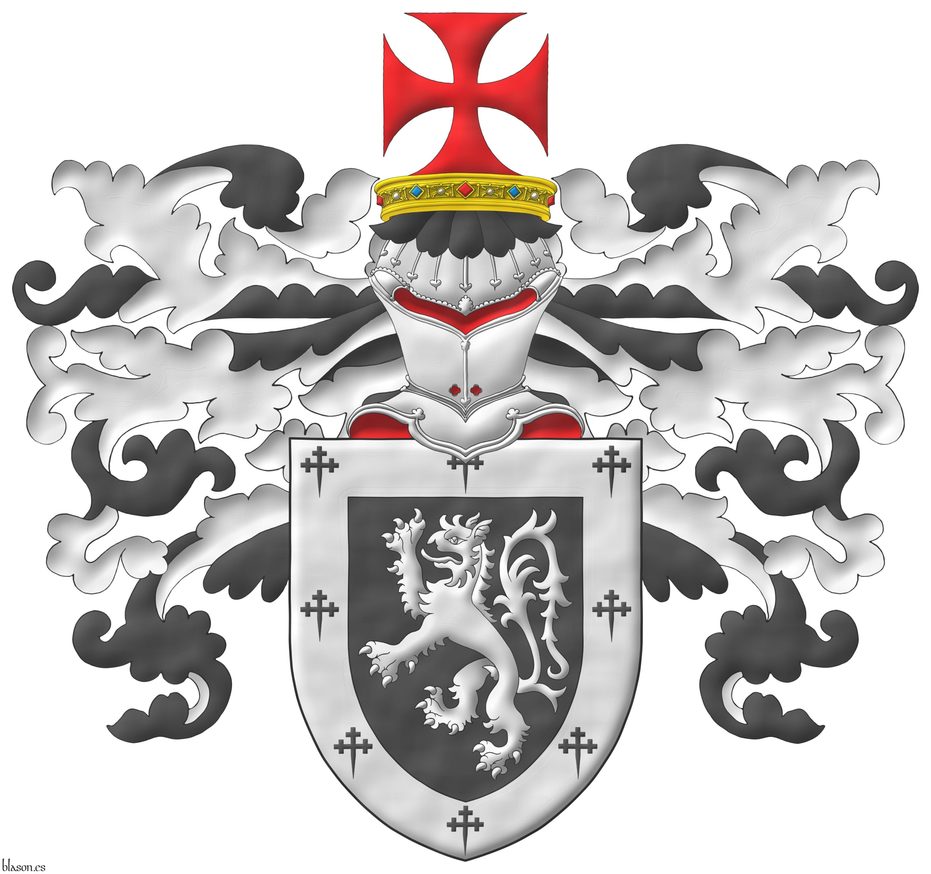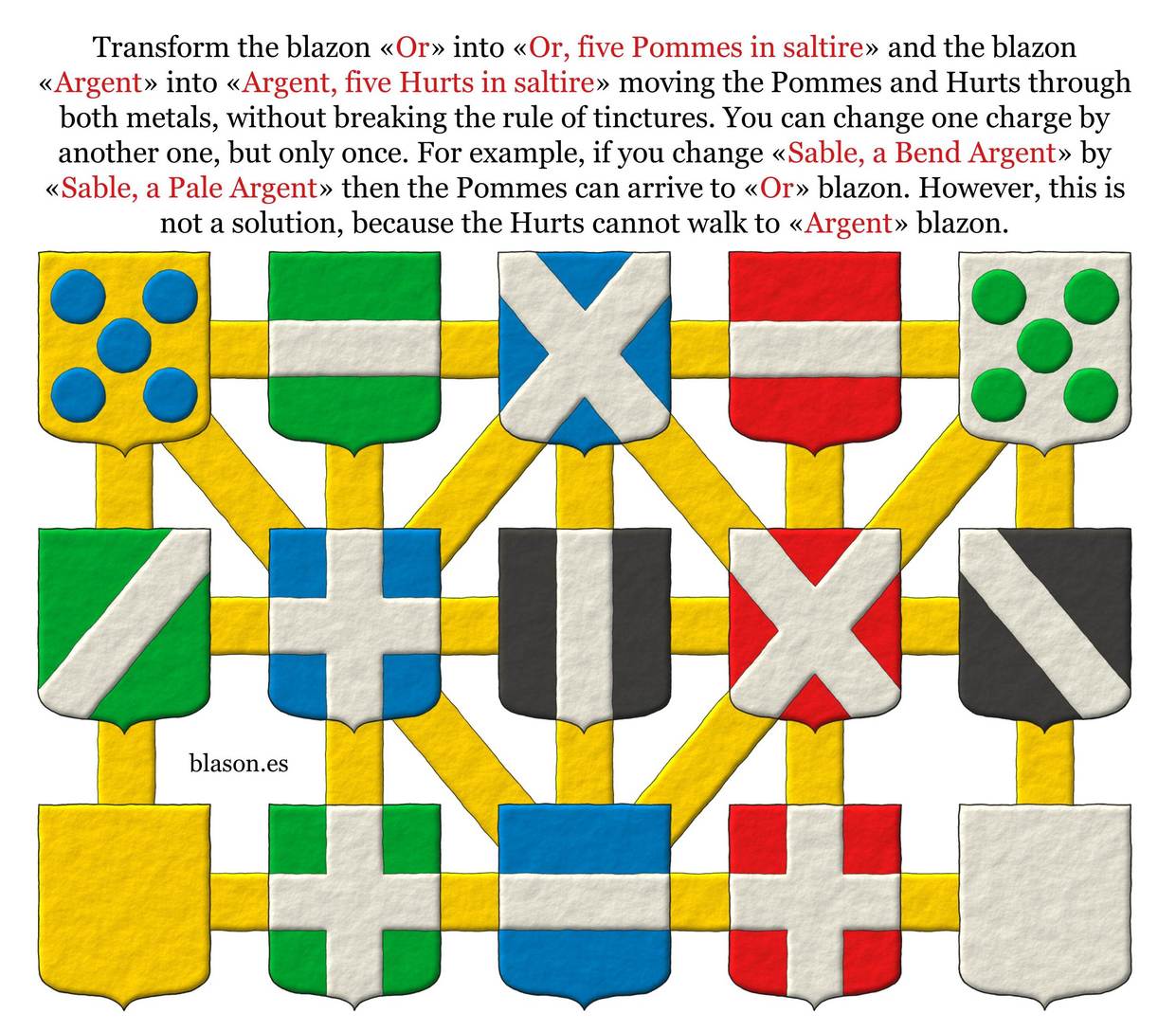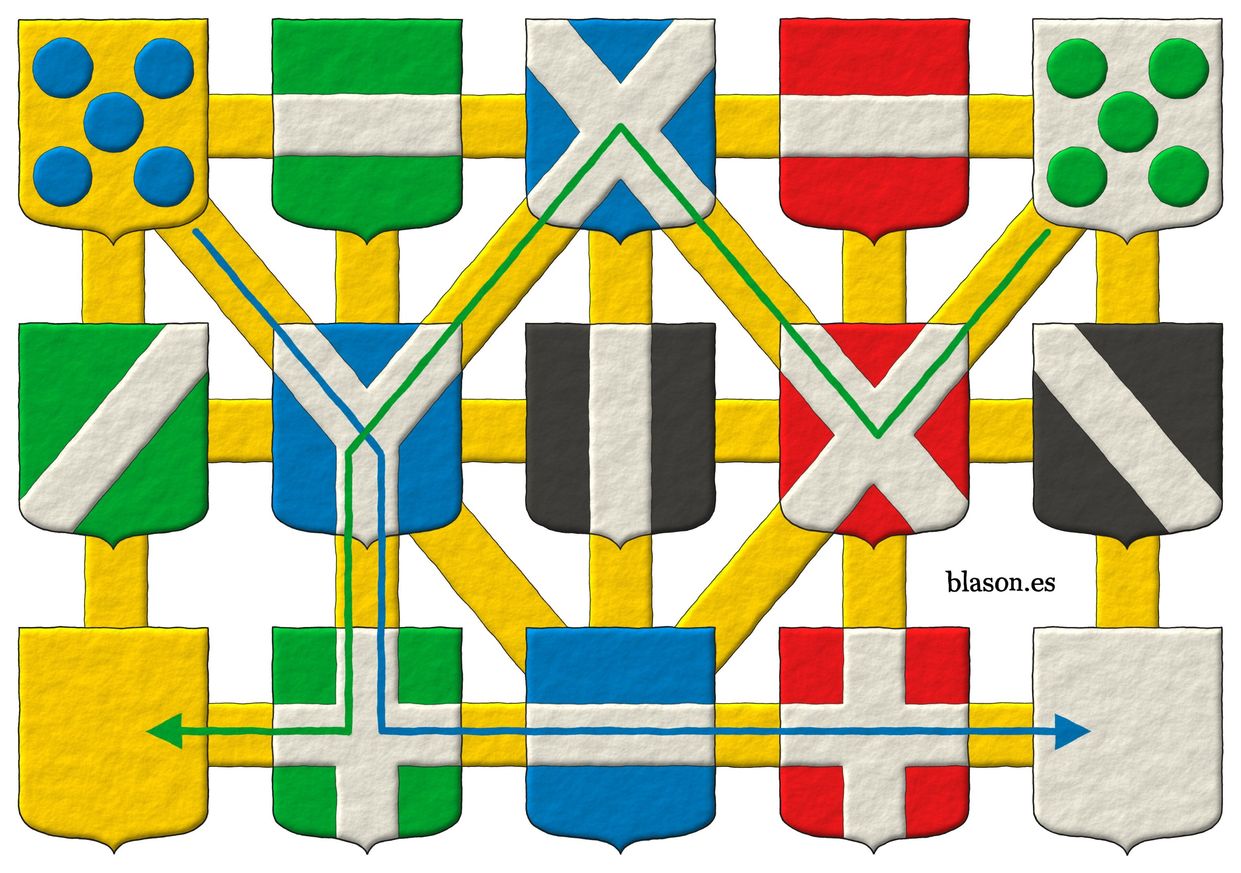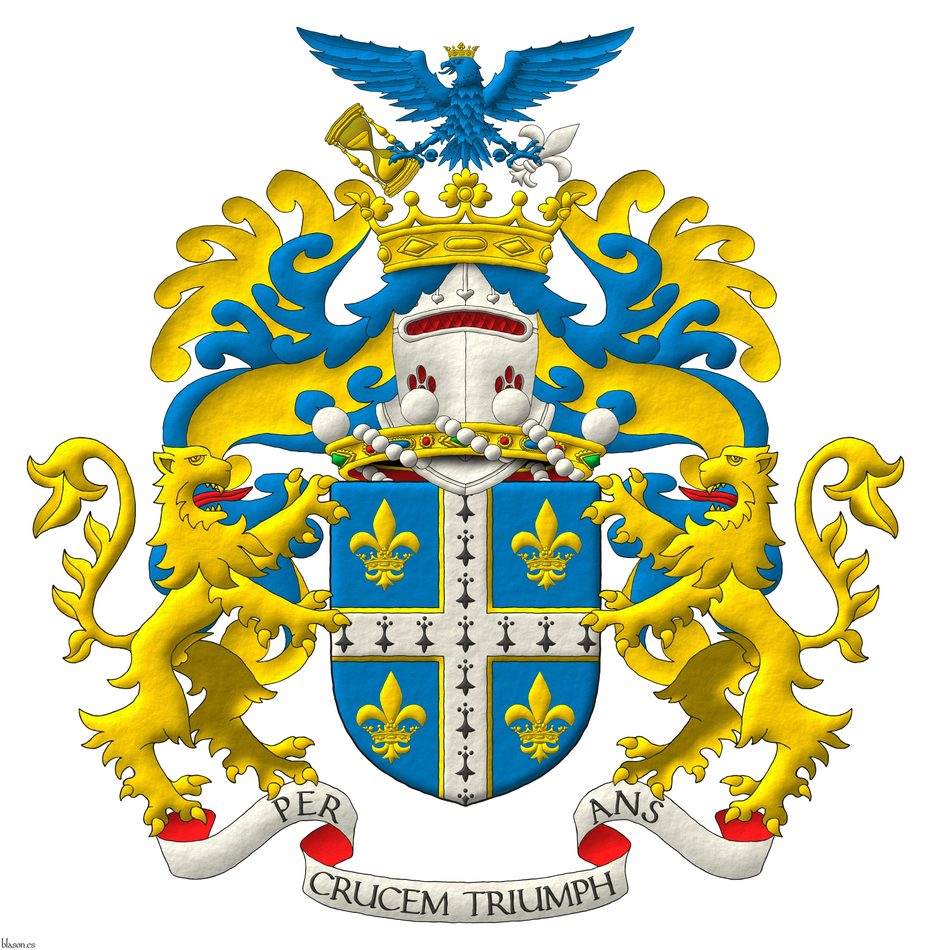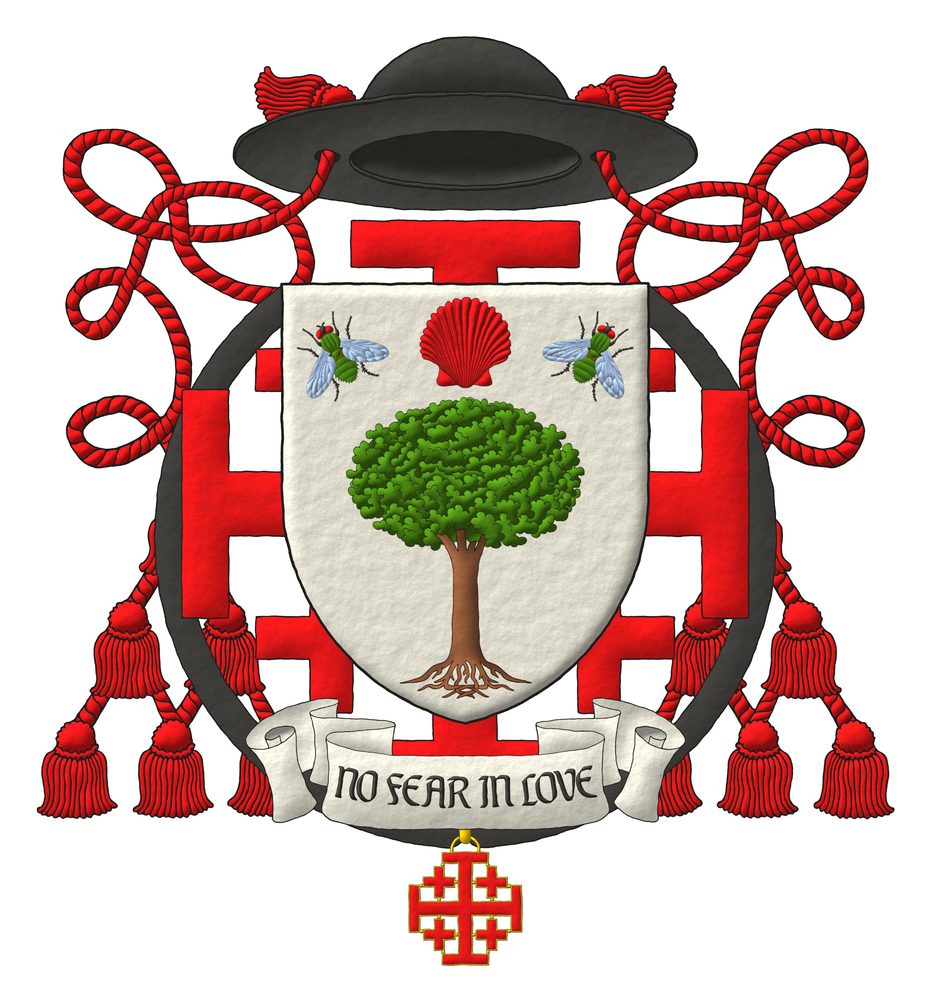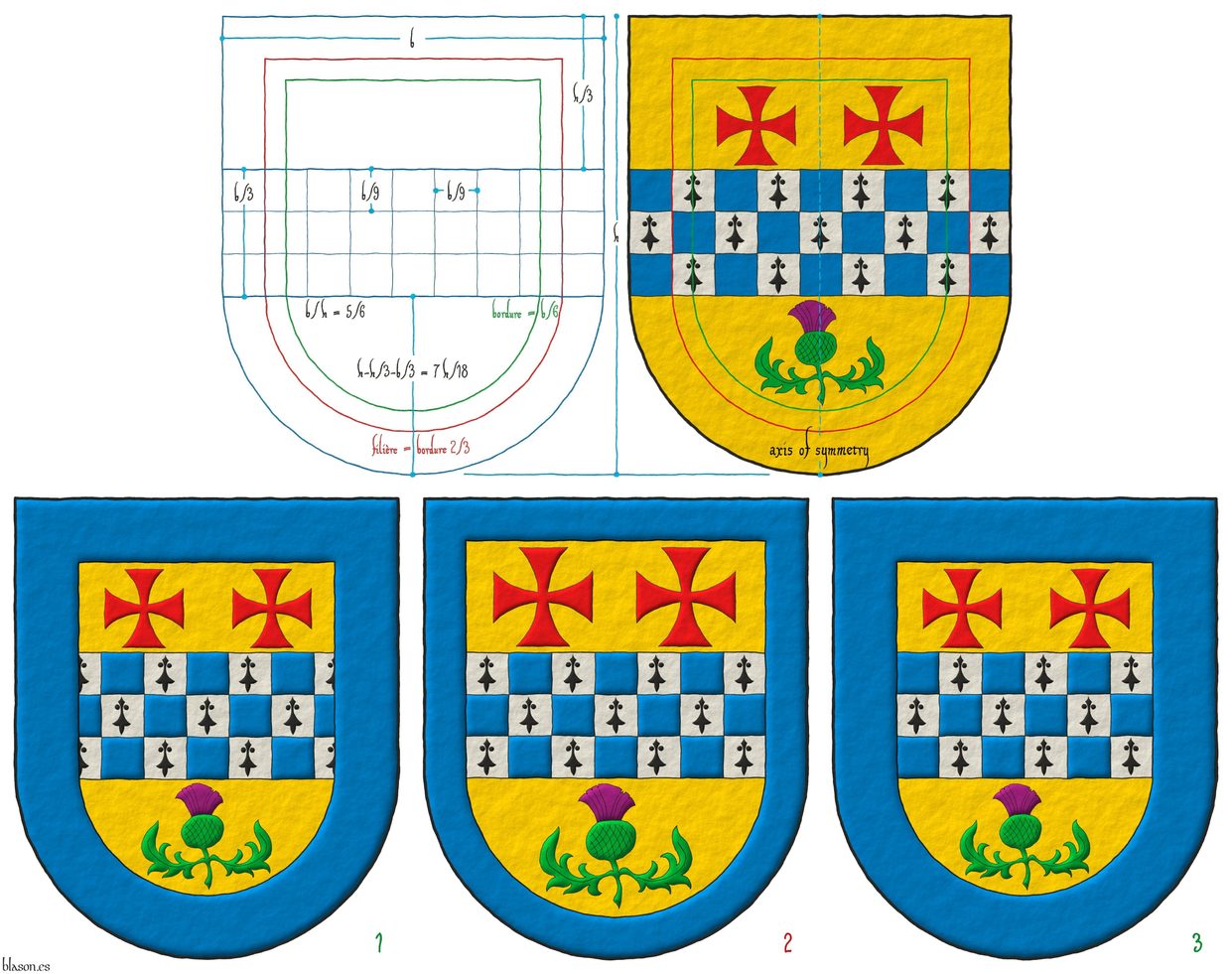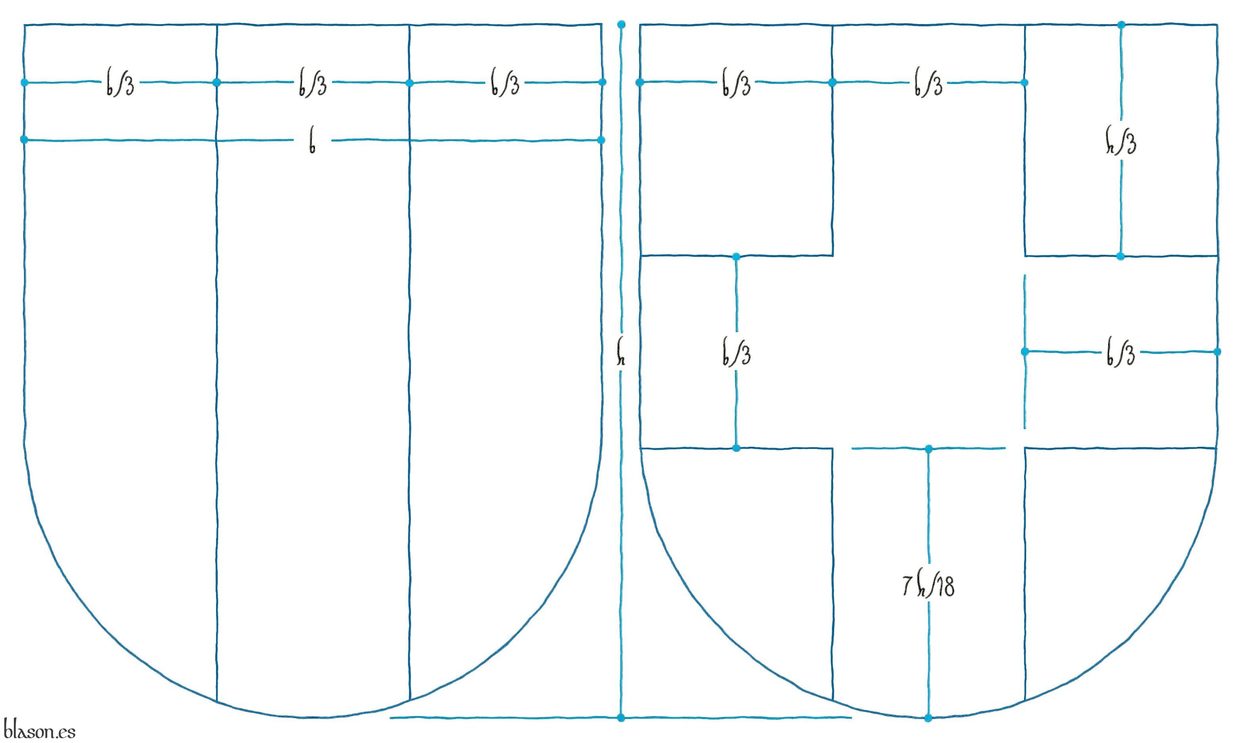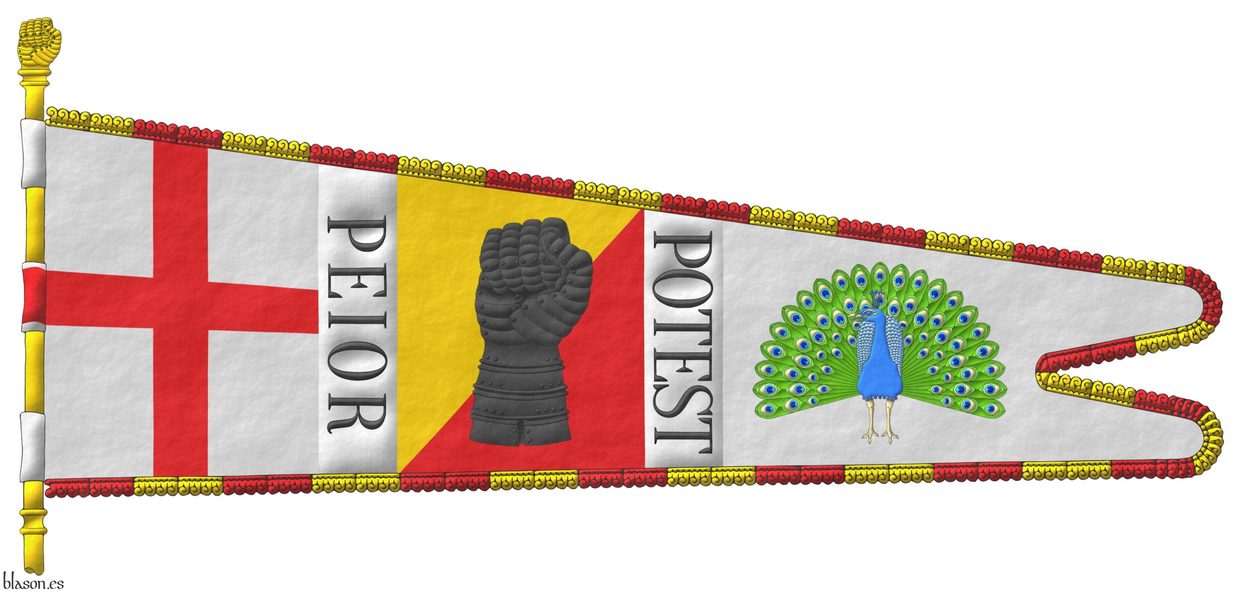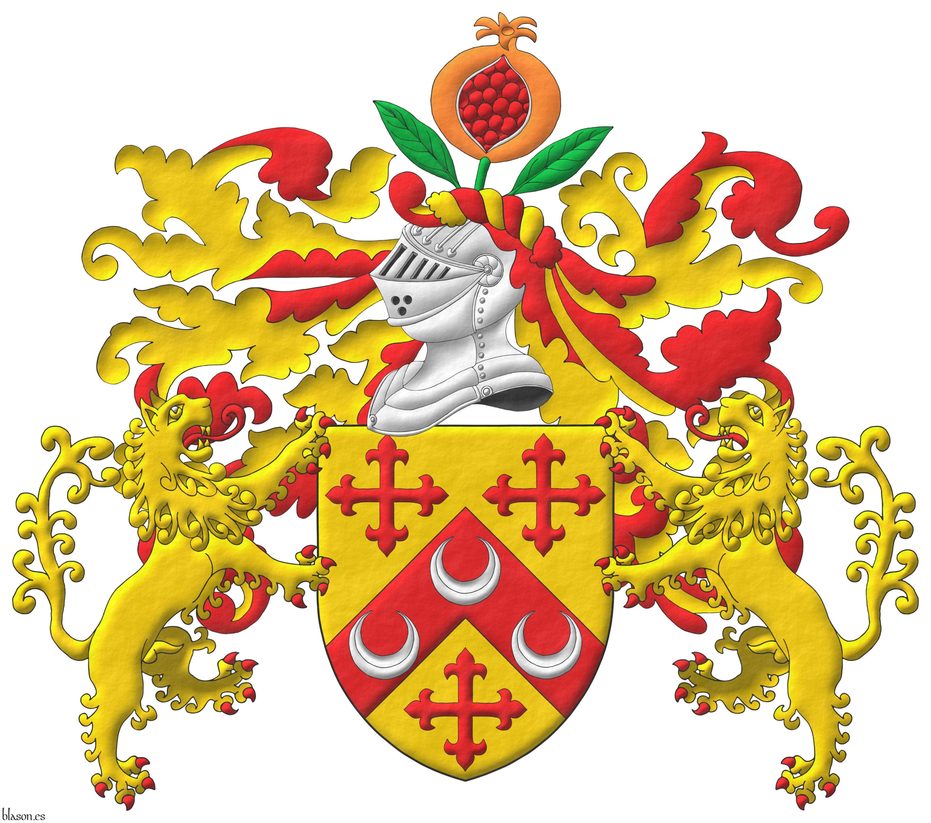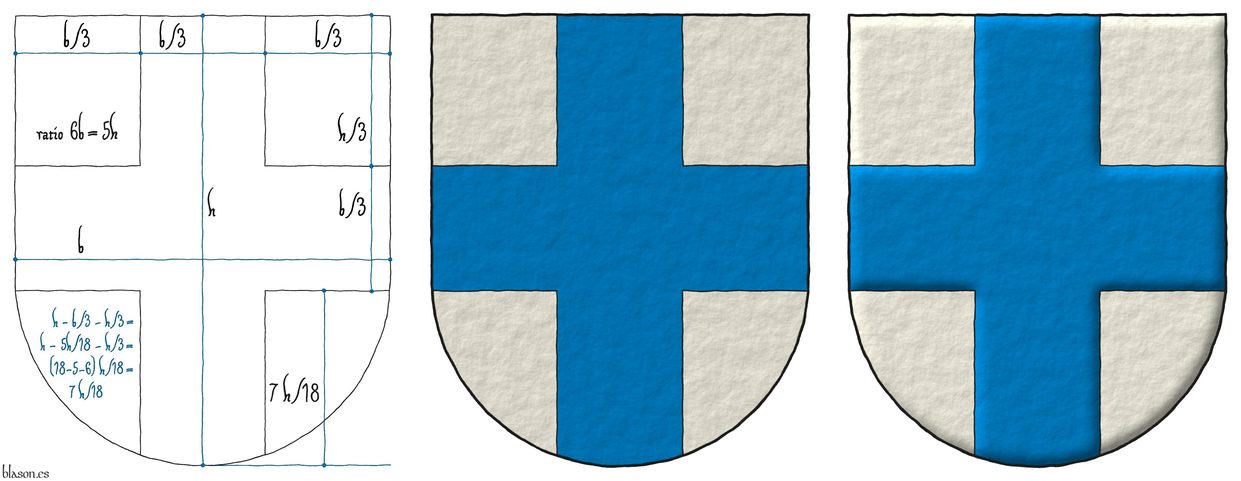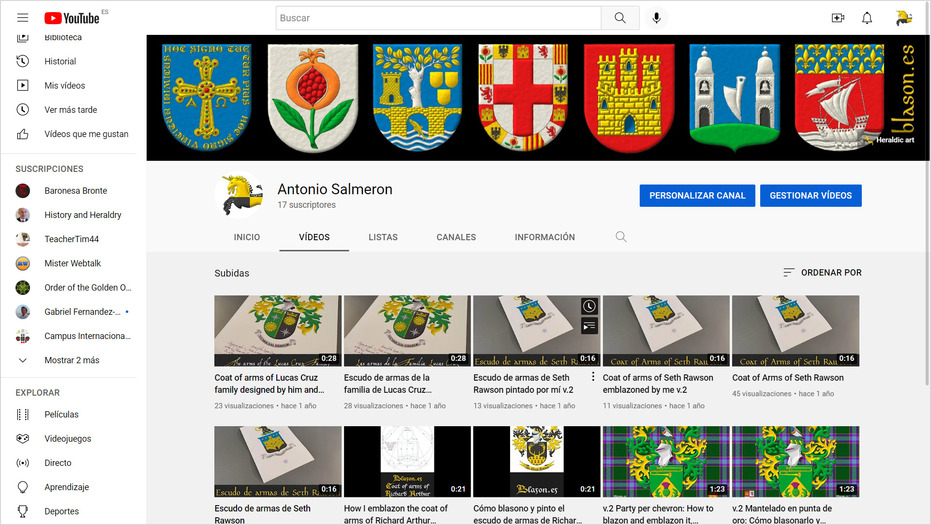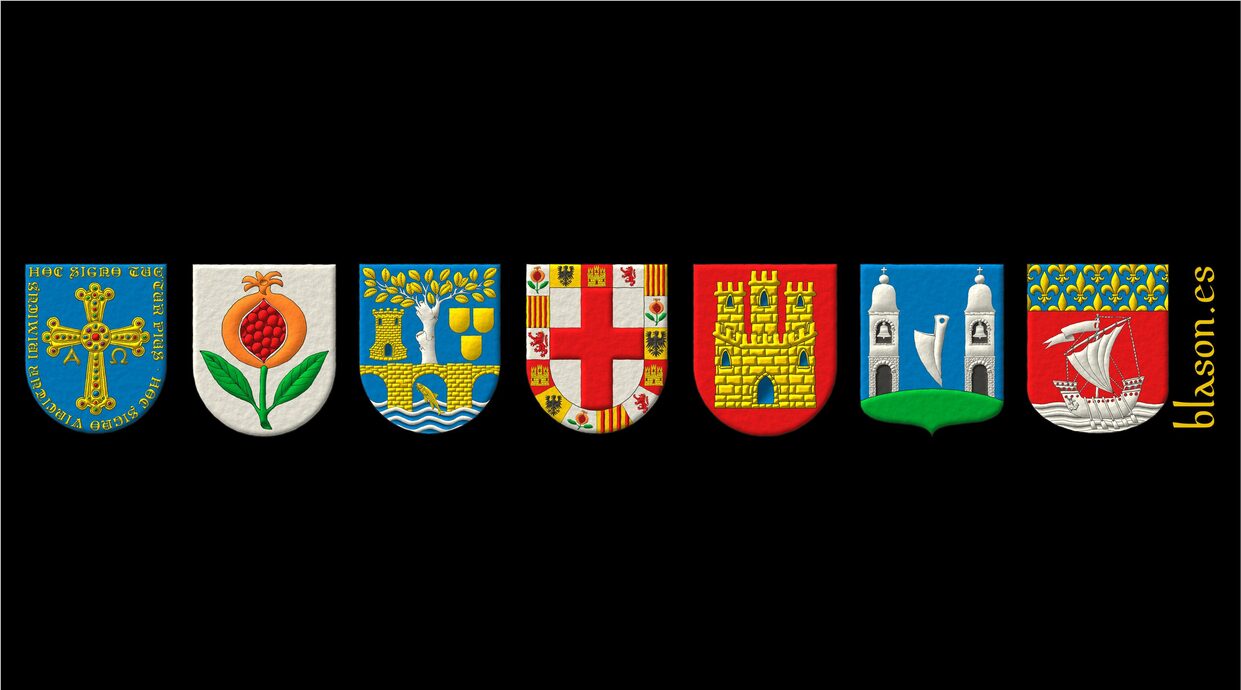Cross


9 coats of arms in the ballroom
There is a series of nine coats of arms in the ballroom of the castle:
- Or, three Fleurs de lis Azure.
- Azure, a Bendsinister Or.
- Or, a Fleur de lis Azure.
- Azure, a Cross Or.
- Or, five Fleur de lis Azure in saltire.
- Azure, a Fess Or.
- Or, two Fleur de lis Azure in bend.
- Azure, a Saltire Or.
- Or, four Fleur de lis Azure.
There are so many Fleurs de lis that everyone, except the joker, calls it the «fleurdelisée» room. Nobody knows the reason why the joker says there is none, do you?
Think before you move the cursor or click on the following link and see the solution.
Categories: Riddle, Or, Azure, Fleur de lis, One, Two, Three, Four, Five, Bend sinister, Cross, Fess and Saltire.


9 coats of arms in the ballroom, solution
Categories: Riddle solution, Ogee, Outlined in sable, Freehand, Or, Azure, Fleur de lis, One, Two, Three, Four, Five, Bend sinister, Cross, Fess and Saltire.


Alarcon of Cantabria, lineage

Gules, a cross flory voided Or; within a bordure Gules with eight saltires couped Or.
Escudo de gules, una cruz hueca flordelisada de oro; bordura de gules, ocho sotueres de oro.
Coat of arms painted by me, highlighted with lights and shadows, outlined in Sable, with a semi-circular external shape and with a freehand finishing.
Ancient arms of Alarcon of Cantabria emblazoned by me.
Blazon keywords: Argent, Sable, Or, Gules, Three, Cross, Flory, Voided, Bordure, Saltire and Couped.
Style keywords: Outlined in sable, Illuminated, Semi-circular and Freehand.
Classification: Personal, Interpreted, Boa and Coat of arms.
Bearer: Alarcon of Cantabria, lineage.


Alfonso Sánchez de Perella, collage
Azure, a cross flory voided Argent; a bordure Gules charged with sixteen saltires couped Or.
Coat of arms emblazoned by me, highlighted with lights and shadows, contoured in Sable, with a semi-circular external shape and with a texturized finishing.
Alfonso Sánchez de Perella, first mayor of Burgos emblazoned by me. He appears as the [Cofradía de Santiago; Century XIV; 4th knight, 1st of the page 21 V], from this 14th century Book of the Brotherhood of Knights of Santiago de la Fuente. This was a brotherhood founded by the Burgos citizens at the time of King Alfonso XI of Castilla, 1311-1350. In the book, there are 14 saltires instead of 16, as it appears that one is missing on the sinister side of the base, and there are 4 in the chief instead of 5.
Blazon keywords: Azure, Argent, Gules, Or, One, Sixteen, Cross, Flory, Voided, Bordure, Saltire and Couped.
Style keywords: Outlined in sable, Illuminated and Semi-circular.
Classification: Personal, Interpreted, Boa and Coat of arms.
Bearer: Sánchez de Perella, Alfonso.


Bailleul, commune of

Gules, a cross vair.
Escudo de gules, una cruz de veros.
Coat of arms interpreted with: a semicircular (round) base; the field in flat tincture of Gules; the vair illuminated and outlined in Sable; and the whole with a roughened finish.
The commune of Bailleul is located in the district of Dunkirk, in the Nord department, in the Nord–Pas-de-Calais region of France.
The coat of arms of Bailleul, called «Belle» in Flemish, is similar to that of the heraldist Gonzalo Argote de Molina, differing in that the commune’s arms bear vair, while the heraldist’s arms bear rounded vair in the ancient style.
Blazon keywords: Without divisions, Gules, Argent, Azure, Cross and Vair.
Style keywords: Semi-circular, Illuminated, Outlined in sable and Rough.
Classification: Interpreted, Civic, Coat of arms and Kingdom of France.
Bearer: Bailleul, commune of.


![Ver [Calatrava, Order of] en instituciones citadas. Fortaleza de oro y mazonada de sable.](../css/Fortaleza.Institucion.png)
Calatrava, Order of
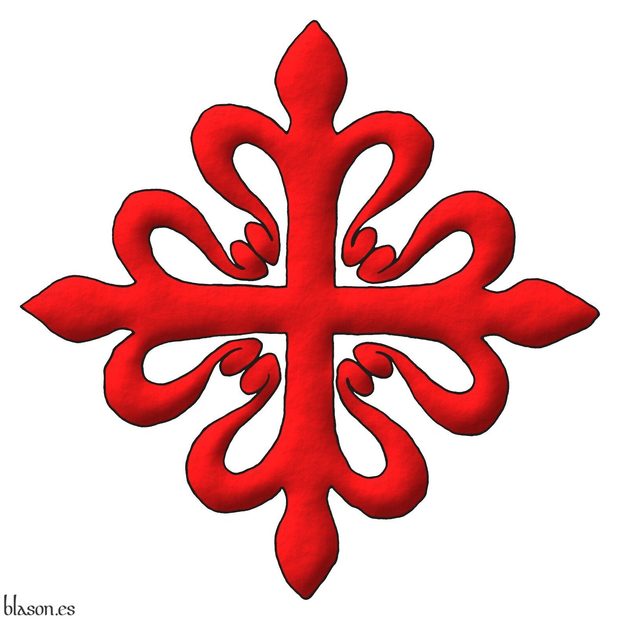
The Order of Chivalry of Calatrava is both military and religious, founded in the Kingdom of Castile during the 12th century by Abbot Raymond of Fitero.
The purpose of its foundation was the protection of the town of Calatrava la Vieja, which currently belongs to the municipality of Carrión de Calatrava in Ciudad Real. At the time of the order's foundation, it was an important city, in the middle valley of the river Guadiana and with a strategic position, as it was a necessary passage on the road from Toledo to Córdoba to Toledo and between the west and east of the Iberian Peninsula.
On the origin and antiquity of the Military Order of Calatrava, and the form of its Commandery
[Avilés, J.; 1780b; treatise IV, chapter IV, pages 334] writes «The Military Order of Calatrava was instituted by Don Sancho III, King of Castile (called the Desired), in the year 1158, while he was visiting his Kingdom; and being in Toledo with news of the great army that the Moors were gathering to besiege Calatrava la Vieja (which is called so today to distinguish it from the new one, which was founded later); and as the Templars, to whom this Fortress belonged, did not have sufficient power to resist such a large multitude, they handed it over to King Don Sancho himself so that he could take charge of it, as he did».
[Avilés, J.; 1780b; treatise IV, chapter IV, page 335] continues by telling us «The Abbot of Santa María de Fitero», near the river Pisuerga as he will indicate next, «of the Congregation of Cistercian, in the Bishopric of Palencia (which is a Monastery of St. Bernard, located on the river Pisuerga), named Don Raymond, and Friar Diego Velazquez, his subject Monk, who followed the Court, despite the difficulty of the enterprise, requested it from the King to defend it, which was granted, trusting in the virtue of the Abbot, and the strength of the Monk, who had previously been a great Knight in deeds of Arms, and very practiced in war».
[Avilés, J.; 1780b; treatise IV, chapter IV, page 336] continues «Seeing themselves in such an obligation, and that by themselves they could not fulfill it, they turned to Archbishop Don Juan (who was the fourth of Toledo) for help; and he, granting many indulgences in all his Archbishopric to those who, for themselves and for others, supplied the Place with provisions, in the same way as those who, unable to go due to old age or illness, helped with weapons, horses, and men; and having spread this news, so much help came to them, that when the Moors learned that the number of people exceeded twenty thousand men, they abandoned the conquest, returning to their homes: for this reason, the King ceded the Town of Calatrava to the Abbot of Fitero, and his successors, to defend it from the Moors from then on, confirmed later by King Alfonso IX, his son».
[Avilés, J.; 1780b; treatise IV, chapter IV, page 337] concludes «Having obtained this grace, Abbot Don Raymond brought the most suitable Monks from Fitero to Calatrava, and everything else that was necessary for living and for the defense of the Town and its land, which with the people inclined to war who remained, formed the Order of Chivalry of Calatrava, taking this name from the place where the institution was made, which in Arabic Calatrava means Castle».
Categories: Institution, Interpreted, Religious, Military, Illuminated, Outlined in sable, Freehand, Emblem, Cross of Calatrava, Cross couped and Cross.


Carlos Vidriales, his arms in my Exhibition at the International Lab
Credits: Pablo Plaza is the author of the photograph and Antonio Salmerón y Cabañas is the author of the heraldic art of the coats of arms photographed.
Categories: Photographic, Coat of arms, Interpreted, Personal, Semi-circular, Illuminated, Outlined in sable, Party per pale, Argent, Cross, Sable, Bordure, Motto, Or, Thirteen, Hurt, Hurt, torteau, pellet, pomme and golpe, Azure, Three, In pale, Four, Five, Chief, Fleur de lis, Lineage, Conjoined in fess, Decoration, Suspended and Base (lower 1/3).
Root: Vidriales García y Bustamante, Carlos.


Cavalry Regiment Alcantara, royal crown
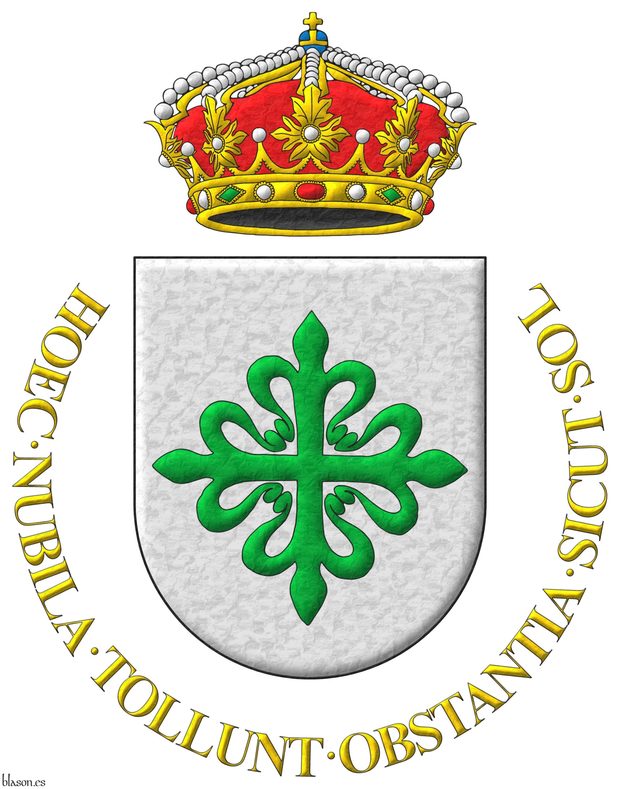
Disperse like the sun clears the clouds in your path.
Argent, a cross of Alcantara. Crest: A closed royal crown Or, with eight arches, visible five. Motto: «Hoec nubila tollunt obstantia sicut sol».
Escudo de plata, una cruz de Alcántara. Timbrado de una corona real cerrada. Lema: «Hoec nubila tollunt obstantia sicut sol».
Coat of arms interpreted in the following manner: the shape of the shield is of a semicircular arch; the field is illuminated in metal Argent; the cross of Alcantara is outlined in Sable and illuminated in Vert; the royal crown is closed, outlined in Sable and illuminated with the metal Or, Argent for the pearls, Azure and Or for the orb, Gules and Vert for the gems, Gules for the inner cloth, and Sable for the visible hollow at its base; and the whole has a slightly hammered metal finish.
Regiment's Motto
The Latin motto «Hoec nubila tollunt obstantia sicut sol» is often translated as «Ride like the sun, disperses the clouds in its path». I would like to offer the following observations on this translation:
- Instead of «disperse», I prefer the verb «scatter» which is more aligned with a cavalry regiment, [Royal Spanish Academy; 2001] «scatter, 3rd meaning, transitive verb, military term: To break up, rout the enemy, causing them to flee and scatter in complete disorder».
- On the other hand, even though it is about cavalry, I do not find that the Latin motto makes reference to riding, a verb that is also not needed to understand the motto's meaning, and adding an extra word lengthens the motto, reducing its impact.
- Finally, I use «your», instead of «its», so that the motto is a direct and personal rallying cry and not a phrase directed at a third person.
Blazon keywords: Without divisions, Argent, Cross of Alcantara, Cross couped, Cross, Crest, Closed royal crown, Crown and Motto.
Style keywords: Semi-circular, Illuminated, Outlined in sable and Soft metal.
Classification: Interpreted, Military, Army and Navy and Coat of arms.
Bearer: Alcantara, Cavalry Regiment.


Cavalry Regiment Montesa, royal crown
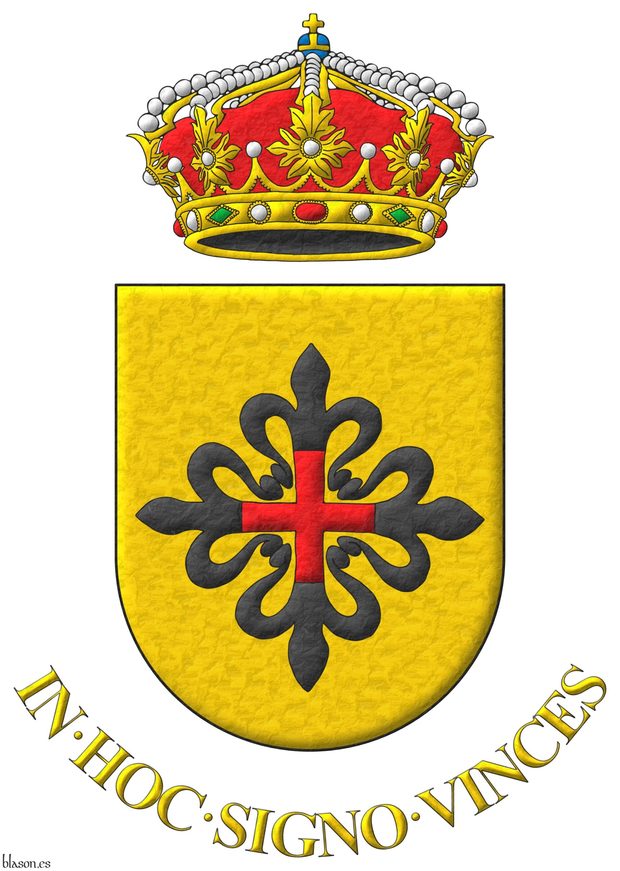
In this sign, you shall conquer.
Argent, a cross of Montesa. Crest: A closed royal crown Or, with eight arches, visible five. Motto: «In hoc signo vinces».
Escudo de oro, una cruz de Montesa. Timbrado de una corona real cerrada. Lema: «In hoc signo vinces».
Coat of arms interpreted as follows: the shape of the shield is a semi-circular arch; the field has been illuminated in metal Or; the cross of Montesa is outlined in Sable and illuminated in Sable and Gules; the royal crown is closed, outlined in Sable and illuminated the metal in Or, the pearls in Argent, the orb in Azure and Or, the gemstones in Gules and Vert, the inner cloth in Gules, and the visible hollow at its base in Sable; and the whole has a slightly beaten metal finish.
Regimental Motto
The Latin motto «In hoc signo vinces» is translated as «In this sign, you shall conquer».
Globus cruciger ~ Orb
It is called orb ~ «globus cruciger», the first in Spanish and the second in Latin, referring to the part of the royal crown, a jewel, or a jewel itself that recreates the shape of the globe topped with a cross.
Blazon keywords: Without divisions, Or, Cross of Montesa, Cross couped, Cross, Crest, Closed royal crown, Crown and Motto.
Style keywords: Semi-circular, Illuminated, Outlined in sable and Soft metal.
Classification: Interpreted, Military, Army and Navy and Coat of arms.
Bearer: Montesa, Cavalry Regiment.


City of Almeria, schema 4x3
Argent, a cross Gules [for Genoa]; a bordure compony of fifteen sections: 1, 6, and 11 Argent, a pomegranate seeded, slipped and leaved proper [for Granada]; 2, 7, and 12 Or, an eagle displayed Sable [for Navarre]; 3, 8, and 13 Gules, a castle triple-towered Or, port and windows Gules, masoned Sable [for Castile]; 4, 9, and 14 Argent, a lion rampant Purple, armed and langued Gules, crowned Or [for Leon]; 5, 10, and 15 Or, four pallets Gules [de Aragon].
Coat of arms of the city of Almeria, Andalusia, emblazoned by me. These arms combines 1+5=6 coats of arms: Genoa, Granada, Castile (with port and windows Gules instead of Azure), Leon (with the lion Gules instead of Purple), Navarre (for its old arms, its «Arrano Beltza» ~ «Black Eagle»), and Aragon, as shown in this composition.
Blazon keywords: Argent, Gules, Or, Sable, Vert, One, Four, Fifteen, Cross, Bordure, Compony, Pomegranate, Slipped, Leaved, Proper, Eagle, Castle, Triple-towered, Port and windows, Masoned, Lion, Rampant, Crowned and Pallet.
Style keywords: Outlined in sable, Illuminated, Semi-circular and Leather.
Classification: Civic, Interpreted, Schema, Boa and Coat of arms.
Bearer: Almeria, city of.


Coat of arms for the Arithmetic
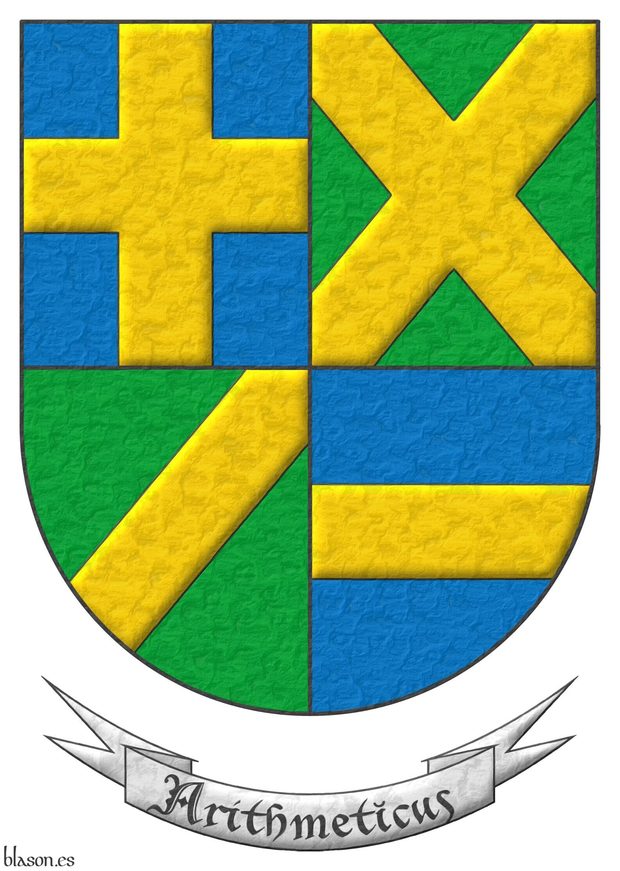
Quarterly: 1 Azure, a cross Or; 2 Vert, a saltire Or; 3 Vert, a bend sinister Or; 4 Azure, a fess Or. Motto: «Arithmeticus».
Escudo cuartelado: 1o de azur, una cruz de oro; 2o de sinople, un sotuer de oro; 3o de sinople, una barra de oro; 4o de azur, una faja de oro. Divisa: «Arithmeticus».
I have made this imaginary coat of arms for the Arithmetic with the following characteristics: a semicircular external shape; its enamelled field with flat color Azure and Vert inks; all the pieces are metal Or, the motto is metal Argent with Sable letters; pieces and motto are illuminated and outlined in Sable; and the whole with a very lightly beaten metal finish.
For the division operation, instead of using the piece bend sinister, 2 bezants Or in pale could have been used. However, since the bezant is a diminished piece, I preferred to use 4 pieces, one for each quarter.
Blazon keywords: Quarterly, Azure, Vert, Or, Cross, Saltire, Bend sinister, Fess and Motto (identification).
Style keywords: Illuminated, Outlined in sable and Soft metal.
Classification: Created, Imaginary and Coat of arms.
Imaginary bearer: Arithmetic.


Crest and mantling of the Lord of South Clifton
Sable, a tyger rampant Argent; a bordure Argent charged with eight crosses crosslet fitchy Sable. Crest: Upon a helm affronty lined Gules, issuant from a crown of Knight, a cross patty Gules. Mantling: Sable doubled Argent.
Coat of arms emblazoned by me, illuminated with lights and shadows, contoured in Sable, with a pointed outer contour and with a watercolor finish.
Blazon keywords: Sable, Argent, Gules, One, Eight, Tyger, Rampant, Bordure, Charged, Cross crosslet fitchy, Crest, Upon (wreath), Helm, Affronty, Lined, Issuant, Crown of Knight, Crown, Cross, Patty, Mantling and Doubled.
Style keywords: Outlined in sable, Illuminated, Pointed and Watercolor.
Classification: Personal, Interpreted, Boa and Coat of arms.
Bearer: South Clifton, Lord of.


Crest, mantling and motto of Brady Brim-DeForest
Party per chevron Gules and Argent, two acorns slipped Or and in base a fleur de lis Azure. Crest: Upon a helm befitting his degree, with a wreath Or and Sable, a demi-lion Or, armed and langued Azure, holding in its paws a swallow-tailed pennon Azure, charged with a cross patty Argent. Mantling: Gules doubled Argent. Motto above the crest: «Un cran plus loin».
Coat of arms interpreted by me, illuminated with lights and shadows, contoured in Sable, with a double pointed outer contour and with a leather finish.
Blazon keywords: Gules, Or, Argent, Azure, Two, One, Party per chevron, Acorn, Slipped, Base, Fleur de lis, Crest, Upon (wreath), Helm, Demi, Lion, Armed, Langued, Grasping, Paw, Charged, Cross, Patty and Motto.
Style keywords: Outlined in sable, Illuminated, Double pointed and Leather.
Classification: Personal, Interpreted, Boa, Coat of arms, Pennon and Flag.
Bearer: Brim-DeForest, Brady.


Crest, mantling and motto of Julio Hector Aspe
Azure, a trumpet bend sinisterwise Or, debruised by a fish haurient Argent, debruised by a sword bendwise point downwards Or, all between two fleurs de lis in fess Argent. Crest: Upon a helm lined Gules with a wreath Or and Azure, a paschal lamb regardant Argent, nimbed Or, supporting a staff Or, flying a flag Argent charged with a cross Gules. Mantling: Azure doubled Or. Motto: «Quis ut Deus».
Coat of arms designed by me, illuminated with lights and shadows, outlined in Sable, with an ogee triple-pointed external shape and with a watercolor finishing.
Blazon keywords: Azure, Argent, Or, Gules, Sable, One, Two, Trumpet, Bend sinisterwise, Debruised, Fish, Haurient, Sword, Point downwards, Between, Fleur de lis, In fess, Crest and mantling, Crest, Upon (wreath), Helm, Wreath, Paschal lamb, Regardant, Nimbed, Grasping, Shafted, Charged, Cross, Mantling and Motto.
Style keywords: Outlined in sable, Illuminated, Ogee Triple-Pointed and Watercolor.
Classification: Personal, Created, Boa, Coat of arms and Flag.
Bearer: Aspe, Julio Hector.


Crest, mantling and motto of the family Simon-Faus
Quarterly: 1 Argent, an oak eradicated Vert, fructed Or; 2 Azure, a tower with a turret Or, port and windows Azure, masoned Sable; 3 Azure, a hound passant Argent, spotted Sable; 4 Argent, a cross Gules. Crest: Upon a helm with a wreath Argent and Azure, five ostrich feathers alternately Azure and Argent. Mantling: Azure doubled Argent. Motto: «Ut Ferrum Fortes» Sable, with initial letters Gules, over a scroll Argent.
Coat of arms devised by me, illuminated with lights and shadows, contoured in Sable, with an ogee external shape and with a leather finishing.
Design rationale
The oak tree laden with acorns Or in the first quarter symbolizes the family's fertility. The oak and the domed tower in the second quarter, in their transformed forms, are elements from the coat of arms of the Simon lineage, which they represent. The third quarter derives from the arms of the Faus family and represents it. The plain cross in the fourth quarter is a symbol of Christ and of Aragon. The Latin motto reads: «Strong as Iron».
Blazon keywords: Argent, Vert, Or, Azure, Sable, Gules, One, Five, Quarterly, Oak, Tree, Eradicated, Fructed, With a turret, Port and windows, Masoned, Dog, Passant, Spotted, Cross, Crest and mantling, Crest, Upon (wreath), Helm, Wreath, Ostrich feathers, Alternately, Mantling and Motto.
Style keywords: Outlined in sable, Illuminated, Ogee and Leather.
Classification: Personal, Created, Design rationale, Boa and Coat of arms.
Bearer: Simon-Faus, family.


Cross potent, cross moline, and cross of Jerusalem, comparison
A Gules and Or comparison between cross potent, cross moline, and cross of Jerusalem
Blazon keywords: Gules, Or, Cross potent, Cross couped, Cross moline, Cross of Jerusalem and Cross.
Style keywords: Freehand, Outlined in sable and Illuminated.
Classification: Schema.


Five hurts and five pommes
Transform the blazon «Or» into «Or, five Pommes in saltire» and the blazon «Argent» into «Argent, five Hurts in saltire» moving the pommes and hurts through both metals, without breaking the rule of tinctures.
You can change one charge by another one, but only once.
For example, if you change «Sable, a Bend Argent» by «Sable, a Pale Argent», then the Pommes can arrive to «Or» blazon. However, this is not a solution, because the Hurts cannot walk to «Argent» blazon.
Think before you move the cursor or click on the following link and see the solution.
Categories: Riddle, Ogee, Outlined in sable, Freehand, Or, Argent, Vert, Azure, Gules, Sable, Hurt, torteau, pellet, pomme and golpe, Hurt, Pomme, In saltire, Fess, Saltire, Bend sinister, Cross, Pale and Bend.


Five hurts and five pommes, solution
For example, if you change «Azure, a Cross Argent» by «Azure, a Pall Argent», then the Pommes can arrive to «Or» blazon and the Hurts can arrive to «Argent» blazon. You can view both paths azure and vert in the following image.
Other solution is to change «Azure, a Cross Argent» by «Azure, a Bordure Argent».
Categories: Riddle solution, Ogee, Outlined in sable, Freehand, Or, Argent, Vert, Azure, Gules, Sable, Hurt, torteau, pellet, pomme and golpe, Hurt, Pomme, In saltire, Fess, Saltire, Bend sinister, Cross, Pale, Bend and Pall.


Full achievement of Jean-Yves de Sainte Croix de la Sabliere
Azure, a cross ermine fimbriated Or, between four fleurs de lis Argent, each enfiled in a crown Or. Crest: Upon a helm befitting his degree, issuant from a crown of Baron, with a wreath Or and Azure, a falcon displayed, belled Azure, crowned Or, holding in its dexter talon an hourglass Or and in its sinister talon a fleur de lis Argent. Mantling: Azure doubled Or. Motto: «Per Crucem Triumphans» Sable, over a scroll Argent, doubled Gules. Supporters: Two lions rampant Or, langued Gules.
Coat of arms depicted by me, illuminated with lights and shadows, contoured in Sable, with a pointed outer contour and with a freehand finish.
G0128, Chief Herald of Arms of Malta's grant for the arms of Jean-Yves, de Sainte Croix de la Sabliere, UK. These arms have been emblazoned by me for such grant.
Blazon keywords: Azure, Or, Argent, Gules, One, Four, Cross, Ermine, Fimbriated, Between, Fleur de lis, Enfiled, Crown, Crest, Upon (wreath), Helm, Issuant, Crown of Baron, Above the shield, Wreath, Falcon, Belled, Crowned, Dexter, Talon, Hourglass, Sinister, Mantling, Doubled, Motto, Scroll, Supporter (animal), Supporter, Lion, Rampant and Langued.
Style keywords: Outlined in sable, Illuminated, Pointed and Freehand.
Classification: Personal, Interpreted, Boa and Coat of arms.
Bearer: Sainte Croix de la Sabliere, Jean-Yves de.


Full achievement of the Reverend John Muscat
Argent, a tree eradicated proper, in chief an escallop reversed Gules, between two flies pilewise proper. Crest: A galero Sable with two cords, one on each side, each with six tassels Gules. Motto: «No Fear In Love». Behind the shield, the cross of the Holy Sepulchre of Jerusalem. The shield is surrounded by the cross of a Knight Commander of the Holy Sepulchre of Jerusalem.
Arms interpreted by me, highlighted with lights and shadows, contoured in Sable, with a pointed external shape and with a freehand finish.
G0117, Chief Herald of Arms of Malta's grant for the arms of the Reverend John Muscat, Honorary Monsignor of the Canon Chapter, Roman Catholic Cathedral of the Assumption, Gozo. These arms have been emblazoned by me for such grant.
Blazon keywords: Argent, Gules, One, Two, Six, Tree, Eradicated, Proper, In chief, Escallop, Between, Fly, Pilewise, Crest, Galero, Cord, Tassel, Motto, Behind the shield, Cross, Surrounded and Decoration.
Style keywords: Outlined in sable, Illuminated, Pointed and Freehand.
Classification: Religious, Interpreted, Boa and Coat of arms.
Bearer: Muscat, John.


Gonzalo Argote de Molina

Gules, a cross vair ancient.
Escudo de gules, una cruz de veros antiguos.
Coat of arms that I have interpreted as follows: the shield has a semicircular (round) base; the field is in flat tincture of Gules; the vair ancient, rounded in the old style, are outlined in Sable and illuminated; and the whole has a raised-stroke drawing.
The coat of arms of the commune of Bailleul is very similar to this coat of arms, with the difference that it is of regular vair instead of ancient, rounded vair, like that borne by Gonzalo Argote de Molina.
Blazon keywords: Without divisions, Gules, Argent, Azure, Cross and Vair ancient.
Style keywords: Semi-circular, Illuminated, Outlined in sable and Metal beaten.
Classification: Interpreted, Personal, Coat of arms and Heraldry and heralds.
Bearer: Argote de Molina, Gonzalo.


Halkosaari, Heikki
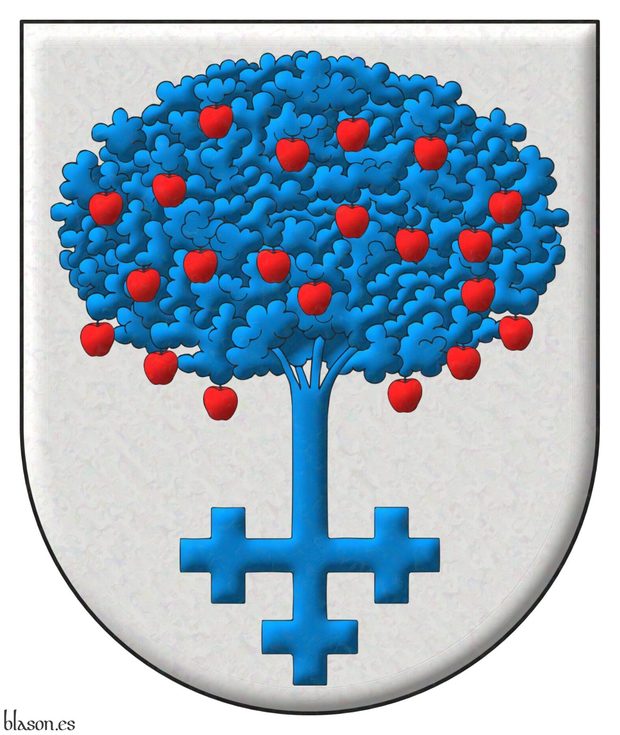
Argent, an apple tree, the base of its trunk forming a cross crosslet Azure, fructed Gules.
Escudo de plata, un manzano con la punta del tronco en forma de cruz recrucetada de Azur, frutado de gules.
Coat of arms painted by me, highlighted with lights and shadows, contoured in Sable, with a semi-circular external shape and with a iridescent finishing.
Blazon keywords: Argent, Azure, Gules, One, Apple tree, Base, Trunk, Cross, Crosslet, Cross couped and Fructed.
Style keywords: Outlined in sable, Illuminated, Semi-circular and Iridescent.
Classification: Personal, Interpreted, Boa and Coat of arms.
Bearer: Halkosaari, Heikki.


ISCH Certification for Tomasz Arkadiusz Grzeszkowiak
The Commoners' Certification of Arms for Tomasz Arkadiusz Grzeszkowiak, arms designed by Tomasz Steifer and emblazoned by me.
Gules, a base enarched Vert, overall a cross patty fitchy Or, piercing in base the head of a serpent nowed and facing sinister Sable, langued Gules. Crest: Upon a helm affronty, with a wreath Sable and Gules, in a front of three ostrich feathers alternately Sable and Gules a paschal lamb Argent, haloed Or and Gules, supporting a staff Or, flying a banner Argent charged with a cross Gules. Mantling: Gules doubled Sable. Motto: «Amor vincit omnia»
In the blazon of this certification, I wrote the expression «a Base enarched Vert», it is correct. But the expression «a Mount Vert» it is also possible. In the original expression in the Polish blazon is «na zielonym wzgórkuon» ~ «the green hill».
Blazon keywords: Without divisions, Gules, One, Mount, Vert, Issuant from base, Overall, Cross patty fitchy, Cross couped, Piercing, Head, Serpent, Nowed, Facing sinister, Sable, Langued, Helm, Affronty, Two, Mantling, Doubled, Wreath, Three, Quill, Alternately, Debruised, Paschal lamb, Argent, Nimbed, Or, Grasping, Shafted, Charged, Cross and Motto.
Classification: Interpreted, Personal, Certification, Heraldic document and Flag.
Bearer: Grzeszkowiak, Tomasz Arkadiusz.


Jamilena, province of Jaen
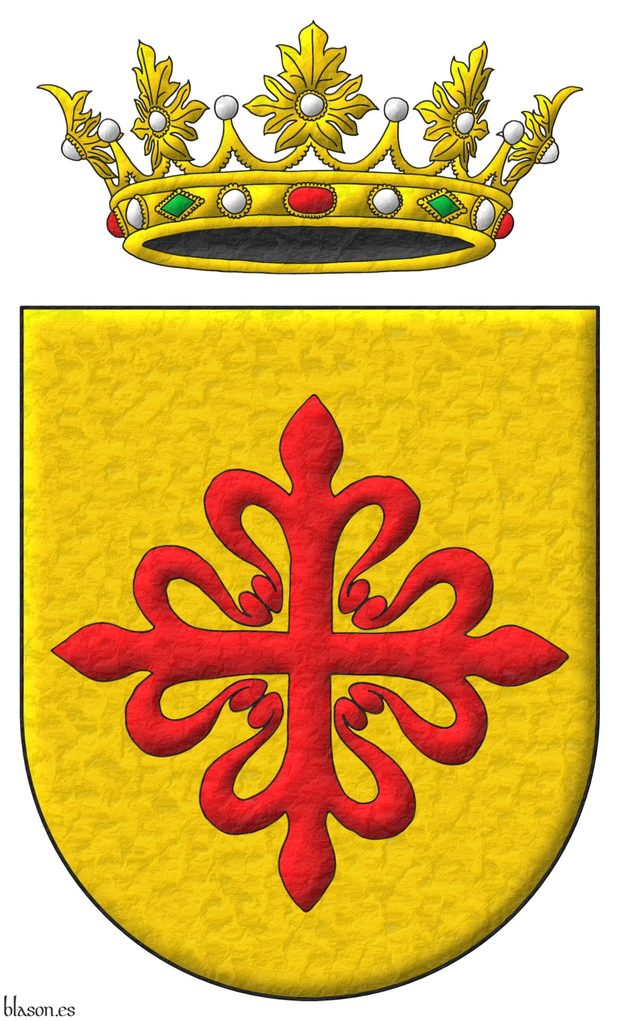
Or, a cross of Calatrava. Crest: An open royal crown Or.
Escudo de oro, una cruz de Calatrava. Timbrado de una corona real abierta.
Coat of arms interpreted as follows: the shield's shape is a semicircular arch; the field is illuminated in metal Or; the cross of Calatrava is outlined in Sable and illuminated in Gules; the royal crown is open, outlined in Sable and illuminated in metal Or, pearls in Argent, gemstones in Gules and Vert, and the visible base hollow in Sable; and the entire piece has a slightly hammered metal finish.
The municipality of Jamilena belongs to the La Campiña region and is the smallest in the province of Jaén. I have depicted its coat of arms with an open royal crown, but representations with a closed royal crown can also be found.
The origin of the cross of Calatrava in its heraldic coat of arms dates back to the year 1525 when Emperor Charles V issued several decrees from Toledo to build a convent for nuns in Jamilena. For the construction of this convent, stones from the Muslim castle, which was reformed and occupied by the Order of Calatrava, were used.
Blazon keywords: Without divisions, Or, Cross of Calatrava, Cross couped, Cross, Crest, Open royal crown and Crown.
Style keywords: Semi-circular, Illuminated, Outlined in sable and Soft metal.
Classification: Interpreted, Civic and Coat of arms.
Bearer: Jamilena.


John Stuart, schema 2x3
Or, a fess chequey Argent, charged with an ermine spot, and Azure, between in chief two cross patty Gules, in base a thistle proper; a diminished bordure Azure.
The coat of arms of Reverend John Stuart, XVIII century, emblazoned by me in 3 approaches: 1) Classic bordure: Using a bordure with a width equal to 1/6 of the coat of arms' base. In the image, this is marked with texts and lines in Vert. Notice that the squares in columns 2 and 8 are split by the inner border of the bordure, which is unfortunate as it disrupts the design. 2) Diminished bordure: Using a narrower bordure with a width equal to 2/3 of the classic bordure, corresponding to 1 square of the fess chequey. In the image, this is marked with texts and lines in Gules. This approach avoids splitting any squares, allows for larger figures, and is my preferred solution. In England, diminished bordures, often simply blazoned as bordure, are more common than in Castile. 3) Without squares splitted: Retaining the classic bordure but shifting the fess chequey 1/2 square to either dexter or sinister to prevent splitting squares. However, this sacrifices the symmetry of the design. This last adjustment was used in the hatchment of Reverend John Stuart in St. George's Cathedral, Kingston, Ontario, 1785.
Blazon keywords: Or, Argent, Azure, One, Three, Nine, Two, Fess, Chequey, Charged, Ermine spot, Between, In chief, Cross, Patty, In base, Thistle, Proper and Diminished bordure.
Style keywords: Ratio, Outlined in sable, Illuminated, Semi-circular and Freehand.
Classification: Personal, Interpreted, Schema, Boa and Coat of arms.
Bearer: Stuart, John.


McMillan Bell of Auchinreoch, Andrew Ronald
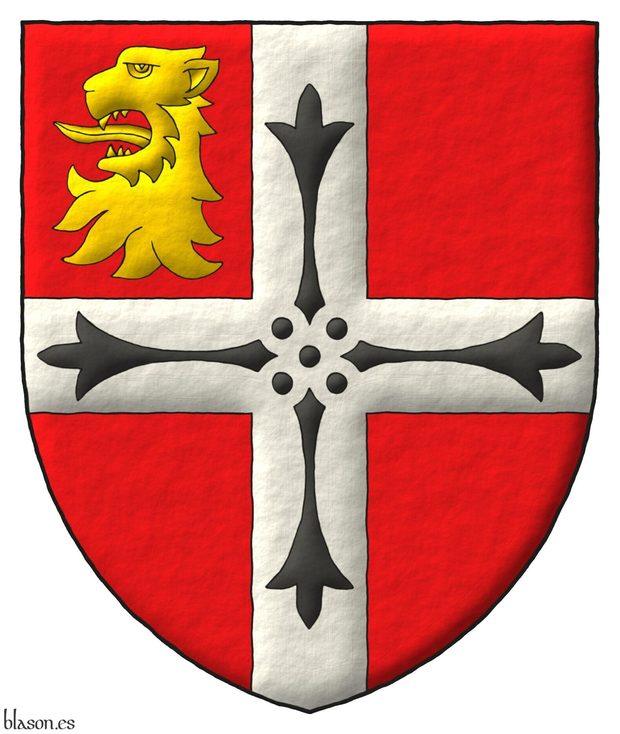
Gules, a cross Argent charged with four ermine spots in cross Sable, in the dexter of the chief a lion’s head erased Or.
Escudo de gules, una cruz de plata cargada de cuatro colas de armiño en cruz, en la diestra del jefe una cabeza de león arrancada de oro.
Arms interpreted by me, highlighted with lights and shadows, outlined in Sable, with a pointed external shape and with a freehand finish.
G0116, Chief Herald of Arms of Malta's grant for the arms of Andrew Ronald McMillan Bell of Auchinreoch, United Kingdom. These arms have been emblazoned by me for such grant.
Blazon keywords: Gules, Argent, Sable, Or, One, Four, Cross, Charged, Ermine, In cross, Dexter, Chief, Lion, Head and Erased.
Style keywords: Outlined in sable, Illuminated, Pointed and Freehand.
Classification: Personal, Interpreted, Boa and Coat of arms.
Bearer: McMillan Bell of Auchinreoch, Andrew Ronald.


![Ver [Montesa, Order of] en instituciones citadas. Fortaleza de oro y mazonada de sable.](../css/Fortaleza.Institucion.png)
Montesa, Order of
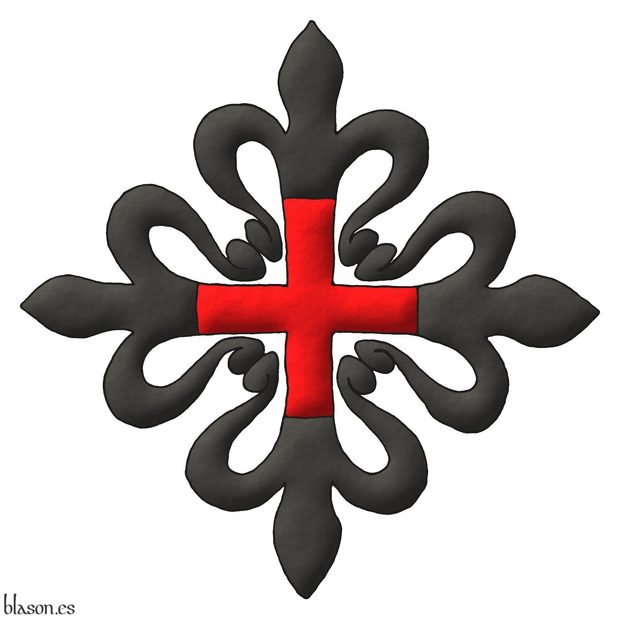
The Order of Saint Mary of Montesa and Saint George of Alfama, known as the Order of Montesa, was founded in the 14th century by the King of Aragon, James, as a military and religious order, to which he donated a castle in Valencia from which they took their name.
To endow the new Order of Montesa, the assets of the Order of the Templars, dissolved by Pope Clement V, were used. This is recounted by [Avilés, J.; 1780b; page 342] writing that Montesa was created «from the incomes and ruin of the Templars; as their Order was being extinguished, at the request of the Kings, so that said incomes would not leave the Kingdom.».
The order established within the Castle of Montesa, which previously belonged to the Templars, their convent and church of the Order, the palace of their Master, their barracks for fighting men, being able to form up to a couple of thousand of them in their parade ground. Their first Master, for 70 days since he died just over two months after his appointment, was Guillermo de Eril.
The origin and antiquity of the Military Order of Montesa, and the form of its Encomienda.
[Avilés, J.; 1780b; treatise IV, chapter VI, page 341] describes it as follows «The Military Order of Montesa was instituted in the year 1317 by the King of Aragon, Don Jaime II, and confirmed in the same year by Pope John XXII.».
Categories: Institution, Interpreted, Religious, Military, Illuminated, Outlined in sable, Freehand, Emblem, Cross of Montesa, Cross couped and Cross.


o-XI, heraldic document
Heraldic document, 2 pages.
The pages have a heraldic frame with the elements of his coat of arms.
The motto, which is the beginning of the Gospel of Saint John, can be seen in [Cnut Gospels; 1020; folio 111].
Blazon keywords: Quarterly, Sable, Or, One, Letter, Two, Wolf, Passant, In pale, Number, Gules, Argent, Azure, Crest and mantling, Helm, Mantling, Wreath, Crest, On, Charged, Disordered, Cross, Cross of Burgundy, Cross couped, Book, Open, Motto, Scroll and Fimbriated.
Classification: Created, Personal, Catalogue, Heraldic document and Frame.
Bearer: Salmerón Cabañas, Antonio.


Order of Alcantara, emblem
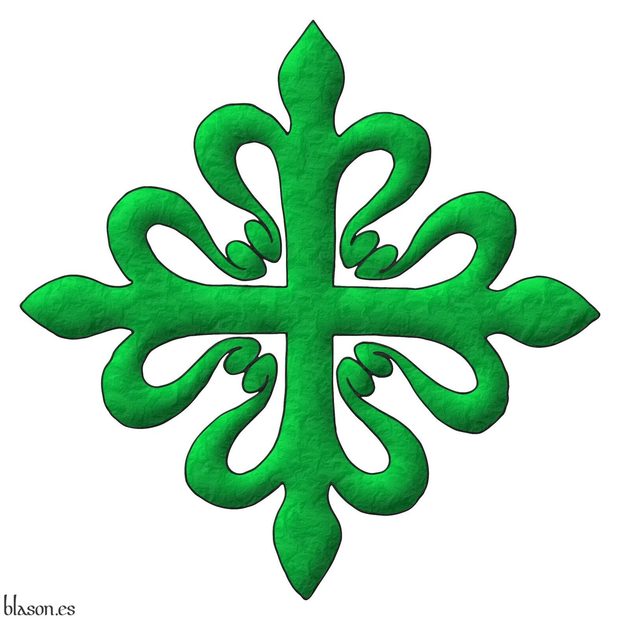
Order of Cavalry of Alcantara
A cross of Alcantara.
Una cruz de Alcántara.
Interpretation of the emblem of the order with: its cross outlined in Sable, illuminated in Vert; and a heavily beaten metal finish.
The Royal Council of the Orders of Chivalry of Santiago, Calatrava, Alcantara, and Montesa, in its historical account of the foundation of the Order of Alcantara, states that, according to Alonso de Torres y Tapia, Prior of Alcantara and a 17th-century chronicler, it was founded in 1156, by Don Suero Fernández Barrientos along with other knights from Salamanca, in Pereiro near the River Coa, under the name of the Order of Saint Julian of Pereiro and during the reign of Ferdinand II of León.
Emblem
Regarding the emblem of the Order of Cavalry of Alcantara, [Avilés, J.; 1780b; treatise IV, chapter V, page 340, figure 102], reusing the same figure 102 as for the Order of Calatrava, says «In the past, the Order of Alcantara displayed on its Standard the Gules Straps of Calatrava», remember that due to the commandery of the city of Alcantara, they had to assume some dependency on that of Calatrava, «next to a Pear tree in Vert on a field of Or, which was the insignia of the Order of Pereiro, due to the conformity with which these two Orders lived; but upon changing their Habit, the Pope» Eugene IV «granted them the green Cross», Vert, «in the manner they wear it today, differing from that of Calatrava only in color».
Blazon keywords: Cross of Alcantara, Cross couped and Cross.
Style keywords: Illuminated, Outlined in sable and Soft metal.
Classification: Interpreted, Religious, Military and Emblem.
Bearer: Alcantara, Order of.


Order of Santiago, emblem

Order of Chivalry of Santiago
A cross of Saint James.
Una cruz de Santiago.
Interpretation of the emblem of the order with: its cross outlined in Sable, illuminated in Gules; and a heavily hammered metal finish.
The Royal Council of the Orders of Chivalry of Santiago, Calatrava, Alcantara, and Montesa, in its historical account of the foundation of the Order of Santiago, describes three different points of view:
- The one presented by tradition, which establishes it in 844, after the battle of Clavijo, when fourteen knights led by the Field Master Don Sancho Martínez de Tejada requested permission from Don Ramiro I, king of Asturias between the years 842 and 850, to found it. This traditional view is the one recorded in [Avilés, J.; 1780b; treatise IV, chapter II, page 325] when discussing the origin of the «Military Order of Santiago of the Sword».
- The perspective of historians like Claudio Sánchez Albornoz or Américo Castro, who question the earlier date. Furthermore, [Sánchez Albornoz, C.; 1965; pages 94-136], as cited in [Domínguez García, J.; 2008; pages 69-70], proposes that the actual battle of Clavijo occurred later, in the year 859, and that Ramiro I did not participate, but rather it was a conflict between King Ordoño I and the Moor Muza.
- The view of historians who, based on the statutes of the order found in the Monastery of Uclés, which was the residence of the Master of the Order of Santiago, and the Latin in which they are written, believe that the foundation could indeed date back to the reign of Don Ramiro I.
Emblem
Regarding the emblem of the Order of Chivalry of Santiago, [Avilés, J.; 1780b; treatise IV, chapter II, page 328, plate 25, figure 100] states «the Commandery of this Order was always a red Sword» (gules ~ red), «in the form of a Cross, just as the guards of the ancient Swords that its Knights and Commanders carried on their white Mantles, and today also on the chest in the same manner, hanging from a red ribbon on a gold medal; that is, in a field of Or, a Cross of Gules».
Blazon keywords: Cross of Saint James, Cross couped and Cross.
Style keywords: Illuminated, Outlined in sable and Soft metal.
Classification: Interpreted, Religious, Military and Emblem.
Bearer: Santiago, Order of.


Province of Cáceres with Cross of Alcántara

Party per pale: 1 Gules, a castle triple towered Or, port and windows Azure, masoned Sable; 2 Argent, a lion rampant Purpure, armed and langued Gules, crowned Or. Crest: An open royal crown. Behind the shield a cross of Alcantara.
Escudo partido: 1o de gules, un castillo de oro, aclarado de azur, mazonado de sable; 2o de plata, un león rampante de púrpura, armado y lampasado de gules, coronado de oro. Timbrado de una corona real abierta. Acolada detrás del escudo una cruz de Alcántara.
Civic coat of arms interpreted by me as follows: the shield of arms has a semicircular (round) base; the quarters are enameled and illuminated in the tinctures Argent and Gules; the castle, the lion, the Cross of Alcántara and the crown are illuminated; the lion and its crown are outlined in the colour of the field; the open royal crown, the Cross of Alcántara and the castle are outlined in Sable; the Cross of Alcántara is fimbriated Or; and the whole has a watercolor finish.
In [Medél, R.; 1846; plate 35, illustration 5] one can see his interpretation of the Cross of Alcántara.
Blazon keywords: Argent, Purpure, Gules, Or, Azure, Party per pale, Castle, Lion, Port and windows, Masoned, Rampant, Armed, Langued, Crowned, Crest and mantling, Crown, Open royal crown, Behind the shield, Cross, Cross of Alcantara and Cross couped.
Style keywords: Semi-circular, Illuminated and Watercolor.
Classification: Interpreted, Civic and Coat of arms.
Bearer: Cáceres, Province of.


Robert George Alexander Balchin
Quarterly: 1 and 4 Vert, a crescent within eight mullets in lozenge Or; 2 and 3 Azure, a chain fesswise throughout between three fleurs de lis, 2 and 1, all the links and fleurs de lis per pale Or and Argent; an inescutcheon Azure, bearing a crown of count, charged with an eagle displayed within a bordure Or. Crest: A crown of Baron. Behind the shield the cross of a Knight of Justice of the Most Venerable Order of the Hospital of Saint John of Jerusalem.
Coat of arms emblazoned by me with a pointed shape, illuminated, and with a watercolor finishing.
G0067, Chief Herald of Malta's grant of Robert George Alexander Balchin's arms, whose full achievement has been emblazoned by me for such grant.
Blazon keywords: Quarterly, Vert, One, Crescent, Eight, Mullet, In lozenge, Or, Azure, Chain, Fesswise, Throughout, Between, Three, Fleur de lis, Ordered, Party per pale, Argent, Inescutcheon, Crest and mantling, Crown of Count, Crown, Charged, Eagle, Bordure, Crown of Baron, Behind the shield and Cross.
Style keywords: Outlined in sable, Illuminated, Watercolor and Pointed.
Classification: Personal, Interpreted, Coat of arms and Doctor.
Bearer: Balchin, Robert George Alexander.


![Ver [Royal Council of the Orders of Chivalry] en instituciones citadas. Fortaleza de oro y mazonada de sable.](../css/Fortaleza.Institucion.png)
Royal Council of the Orders of Chivalry
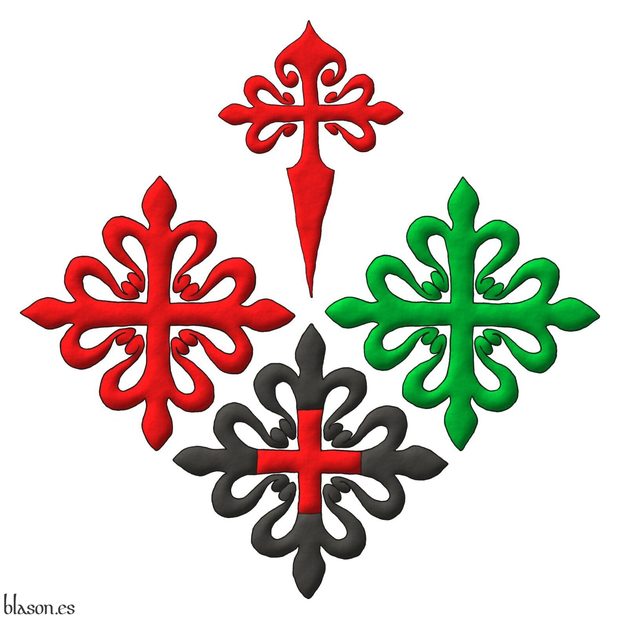
In 1523, the Order of Santiago, the Order of Calatrava, and the Order of Alcantara were definitively incorporated into the Crown of Castile, which marked the consolidation of the Royal Council of the Orders of Chivalry of Santiago, Calatrava, Alcantara, and Montesa. However, it is known that this Royal Council already existed at the beginning of the same 16th century, or even earlier, although there are no foundational documents available to date its inception.
The internet address of its website is ordenesmilitares.es where it also hosts the pages dedicated to each of its four orders:
- Order of Chivalry of Santiago: ordenesmilitares.es/orden-de-santiago.
- Order of Chivalry of Calatrava: ordenesmilitares.es/orden-de-calatrava.
- Order of Chivalry of Alcantara: ordenesmilitares.es/orden-de-alcantara.
- Order of Saint Mary of Montesa and Saint George of Alfama: ordenesmilitares.es/orden-de-montesa.
After the Crusades ended and following the model of the military orders created in the Holy Land, European kings established Orders of Chivalry, many of which were military and religious institutions, like the four grouped under this Royal Council.
Categories: Institution, Interpreted, Socioeconomic, Illuminated, Outlined in sable, Freehand, Emblem, Cross, Quarterly per saltire, Cross of Saint James, Cross couped, Cross of Calatrava, Cross of Alcantara and Cross of Montesa.


Savoy, Duchy of
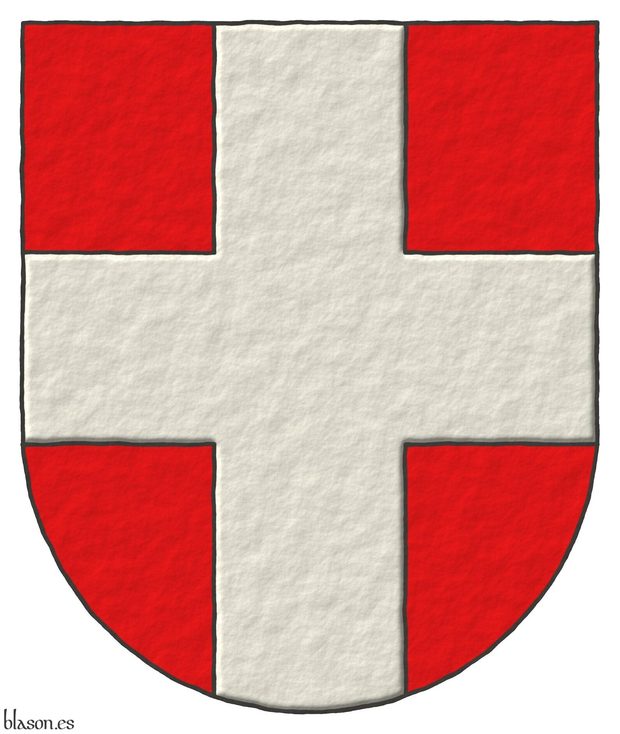
Gules, a cross Argent.
Escudo de gules, una cruz de plata.
Coat of arms of the House of Savoy and the Duchy of Savoy, which I have interpreted as follows: the shield has a semicircular (round) base; the field is illuminated in flat tincture Gules; the cross is illuminated in Argent; and the whole coat of arms is rendered with a raised-stroke effect.
This coat of arms is both familial and political, for it is also the coat of arms of the French departments of Savoy and Haute-Savoie, both belonging to the Rhône-Alpes region.
The cross in this shield is an honourable ordinary, for it is a full cross, the result of combining a fess and a pale. This full cross is wide and reaches the edges of the shield and is therefore large enough to bear charges. For this reason these ordinaries are called “honourable,” because they may be honoured with additional charges. In English heraldry they are known as «ordinaries», [The Heraldry Society; 2013; page 11].
This coat of arms is recorded in the armorial [Marshal, L.; 1295; shield number 32] together with the text «Le Counte de Sauveys, Gules a cross argent, Amadeus V, Comte de Savoie».
Blazon keywords: Without divisions, Gules, Argent and Cross.
Style keywords: Semi-circular, Illuminated and Freehand.
Classification: Interpreted, Personal, Coat of arms and House of Savoy.
Bearer: Savoy, Duchy of.


Scheme with a pale and a cross
Proportions of the cross and its similarity with the pale.
This schema shows two coats of arms, the first with the proportion scheme of a pale, the second with the proportion scheme of a cross, and allows us to observe the common proportions between a pale and a cross.
Blazon keywords: Without divisions, Pale and Cross.
Style keywords: Semi-circular.
Classification: Schema and Coat of arms.
Bearer: Saboya, Ducado de.


Standard of Tim Wilkins
Structure of this standard:
- Argent, a cross gules.
- The 1st line of his motto.
- His coat of arms.
- The 2nd line of his motto.
- His badge.
Blazon keywords: Cross, Gules, Motto, Party per bend sinister, Or, Surmounted, Gauntlet, Sable, Palewise, Peacock, In his splendour and Proper.
Classification: Personal, Interpreted, Standard and Flag.
Bearer: Wilkins, Tim.


Supporters and crest of Nick Allen Rica II
Or, on a chevron, between three crosses flory Gules, three crescents Argent. Crest: Upon a helm, with a wreath Or and Gules, a pomegranate Proper, seeded Gules, slipped and leaved Vert. Mantling: Gules doubled Or. Supporters: Two Lions rampant Or, langued and armed Gules.
Blazon keywords: Or, One, Chevron, Gules, Charged, Three, Crescent, Argent, Between, Cross, Flory, Crest and mantling, Helm, Mantling, Wreath, Crest, Pomegranate, Proper, Slipped, Leaved, Vert, Supporter (animal), Supporter, Two, Lion, Rampant, Langued and Armed.
Style keywords: Outlined in sable, Pointed, Illuminated and Rough.
Classification: Personal, Created and Coat of arms.
Bearer: Rica II, Nick Allen.


The coat of arms of Gilbert Hérail in 3 steps
Argent, a cross Azure.
Blazon keywords: Argent, One, Cross and Azure.
Style keywords: Outlined in sable, Illuminated, Semi-circular, Plain tincture and Freehand.
Classification: Religious, Military, Knights Templar, Interpreted, Coat of arms and Schema.
Bearer: Hérail, Gilbert.


Trading Pro School
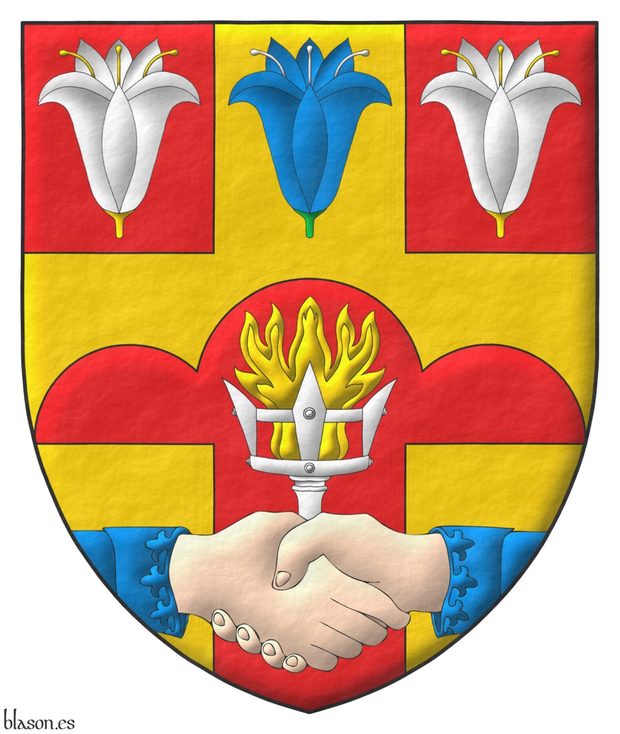
Illuminated and a rough finishing.
Blazon keywords: Gules, Cross, Or, Lily, Slipped, Seeded, Argent, Azure, Vert, In chief, Charged, Trimount, Counterchanged, Torch, In base and Two hands clasped.
Style keywords: Rough, Outlined in sable, Illuminated and Pointed.
Classification: Socioeconomic, Created and Coat of arms.
Bearer: Trading Pro School.


UBU

Purpure, a castle triple-towered Or, port and windows Azure, masoned Sable; on a chief Azure, a cross patty Or, between two escallops Argent.
Escudo de púrpura, un castillo de oro, aclarado de azur, mazonado de sable; un jefe de azur, cargado de una cruz patada de oro acompañada de dos veneras de plata.
Coat of arms interpreted as follows: with a semicircular (round) base; the field and the chief in the flat tinctures Purpure and Azure, with a lightly-hammered metal finish; and the four charges outlined in Sable, shaded, illuminated, and with a very hammered metal finish.
I hold the University Specialist degree in Real Estate Management and Administration, awarded by the Department of Private Law of the University of Burgos. These studies are structured over three academic years and are pursued online in combination with periods of traditional classes in the summers and on-site examinations during the winters. This was my first long-term online training experience.
Blazon keywords: Purpure, Or, Azure, Sable, Argent, Castle, Chief, Cross, Cross patty, Cross couped and Escallop.
Style keywords: Semi-circular, Illuminated, Shaded, Outlined in sable, Soft metal and Hard metal.
Classification: Interpreted, Socioeconomic and Education.
Bearer: Burgos, University of.


Vidriales, C. M.

Interpreted coat of arms: with a semi-circular shape; illuminated with metals argent and or and colors sable and azure; outlined with sable; and a freehand finish.
Blazon keywords: Party per pale, Argent, Cross, Sable, Bordure, Motto, Or, Thirteen, Hurt, Hurt, torteau, pellet, pomme and golpe, Azure, Three, In pale, Four, Five, Chief, Fleur de lis, Label and Suspended.
Style keywords: Freehand, Semi-circular, Illuminated and Outlined in sable.
Classification: Coat of arms, Interpreted and Personal.
Bearer: Vidriales, C. M..


Vidriales, M. P.

Interpreted coat of arms: with a semi-circular shape; illuminated with metals argent and or and colors sable and azure; outlined with sable; and a freehand finish.
Blazon keywords: Party per pale, Argent, Cross, Sable, Bordure, Motto, Or, Thirteen, Hurt, Hurt, torteau, pellet, pomme and golpe, Azure, Three, In pale, Four, Five, Chief, Fleur de lis, Cantoned and Martlet.
Style keywords: Freehand, Semi-circular, Illuminated and Outlined in sable.
Classification: Coat of arms, Interpreted and Personal.
Bearer: Vidriales, M. P..


YouTube
Heraldry videos
- Heraldic panther on the arms of the residential neighborhood of Centro, Val'Quirico, Tlaxcala, Mexico.
- Pennon of the residential village of Abundanttia, Val’Quirico, Tlaxcala, Mexico.
- Jean-Christophe Loubet del Bayle's arms.
- Arms of Juan Lanzagorta Vallin.
- How I emblazon the coat of arms of Richard Arthur Brinnhard.
- Coat of arms of Lucas Cruz's family.
- Pennon of Centro, Val’Quirico, Tlaxcala.
- Arms of Jean-Christophe Loubet del Bayle emblazoned by me step by step.
- Standard of Rudolf Juchter van Bergen Quast.
- Coat of arms of Lucas Cruz family designed by him and me and emblazoned by me.
- Coat of arms of Seth Rawson emblazoned by me v.2.
- Coat of Arms of Seth Rawson.
- v.2 Party per chevron: How to blazon and emblazon it, example, Laird Sky's arms.
- v.1 Party per chevron: How to blazon and emblazon it, example, Laird Sky's arms.
- Coat of Arms of Mr. Paul Bengamin Lindsay.
Heraldic channel
My heraldic channel at YouTube is youtube.com/user/ASalmeronTube.
Categories: Technology, Social networks, Cross, Argent, Pomegranate, Bridge, Tower, Escutcheon, Tree, Fish, Bordure, Compony, Eagle, Lion, Pale, Castle, Bell tower, Plough share, Ship, Semé and Fleur de lis.
-
Language
-
Categories of heraldry
-
Divisions of the field
- Without divisions
- Party per pale
- Party per fess
- Party per bend
- Party per bend sinister
- Tierce
- Tierce sinister
- Tierced per fess
- Tierced per bend
- Tierced pallwise inverted
- Quarterly
- Quarterly per saltire
- Gyronny
- Party per fess, the chief per pale
- Party per pale, the sinister per fess
- Party per fess, the base per pale
- Party per pale, the dexter per fess
- Chapé
- Chaussé
- Party per chevron
- Enté en point
- Flanched
-
Metals
-
Colours
-
Furs
-
Other tinctures
-
Ordinaries and sub-ordinaries
-
Diminutives of the ordinaries
-
Other charges
-
Charges from Nature
Water, Eagle, Bald eagle, Eagle claw, Dorsal fin, Tail fin, Two hands clasped, Lark, Tree, Trunk, Rainbow, Atom, Barbel, Acorn, Bighorn sheep, Arm, Owl, Vulture, Horse, Head, Goat, Camellia, Thistle, Merino ram, Kapok tree, Stag, Doe, Crescent, Increscent, Chrysanthemum, Tail, Tail addorsed, Ermine spot, Hummingbird, Snowflake, Heart, Roe deer, Neck, Roe deers' attires, Raven, Dolphin, Diamond, Tooth, Elephant, Emerald, Starling, Mullet, Mullet of four points, Star of David, Estoile, Male figure, Fleur de lis, Flower, Cornflower, Dogwood flower, Lotus flower, Hop cone, Bluebonnet, Puffin, Ash, Rooster, Claw, Talon, Goose, Heron, Seagull, Pomegranate, Sunflower, Swallow-tail, Falcon, Leaf, Boar, Goldfinch, Laurel, Barn owl, Lion, Lioness, Lion passant, Leopard, Lion rampant guardant, Lynx, Lily, Madonna lily, Flame, Wolf, She-wolf, Parrot, Moon, Hand, Apple, Apple tree, Sea, Martlet, Wing, Two wings in vol, Covert, Blackbird, Mount, Trimount, Fly, Wrist, Elm, Olive tree, Orbital, Bear, Palm frond, Palm tree, Dove, Poplar leaf, Panther, Jaguar, Vine, Paw, Forepaw, Foot (palmiped), Foreleg, Peacock, Chest, Pelican, Pelican in her piety, Dog, Brach hound, Warren hound, Fish, Hoof, Beak, Quill, Cinquefoil, Quetzal, Branch, Sprig, Frog, Shamrock, Caboshed, Oak, Holm oak, Rose, Double rose, Savage, Serpent, Plough of Ursa Major, Sun, Sun in splendour, Ray of the sun, Lightning flash, River, Stem, Badger, Tyger, Linden, Wheat, Wheat spike, Bull, Tulip, Udder, Escallop and Fox.
-
Artificial charges
Halberd, Plough share, Ace of spades, Anchor, Cyclamor, Torch, Bow, Arch, Harp, Non-classic artifact, Winnowing fan, Crozier, Conductor's baton, Pair of scales, Ship, Oar, Sail, Norman ship, Beret, Grenade, Ecclesiastical cap, Arm vambraced, Knight, Chain, Covered cup, Monstrance, Bell, Bell tower, Cannon dismounted, Carbuncle, Castle, Ribbon, Clarion, Nail, Cord, Dagger, Key ward, Turret, With a turret, Armillary sphere, Sword, Federschwert, Sabre, Parchment, Scroll, Arrow, Club, Garb, Sheaf of tobacco, Scythe, Gauntlet, Axe, Buckle, Galician granary, Polish winged hussar, Church, Oil lamp, Spear, Spear's head, Fleam, Letter, Book, Open book, Closed book, Bookmark, Page, Line, Lantern, Key, Four crescents joined millsailwise, Hammer, Menorah, Mortar, Pestle, Number, Knot, Celtic Trinity knot, Water-bouget, Comb, Piano, Millstone, Millrind, Millwheel, Clay pot, Bridge, Cuffed, Hourglass, Chess rooks, Compass rose, Rosette of acanthus leaves, Mullet of six points pierced, Broken, Portcullis, Wheel, Wagon-wheel, Symbol, Sackbut, Drum, Geometric solid, Tetrahedron, Tower, Trident, Trumpet, Double vajra and Anvil.
-
Immaterial charges
Angel, Archangel, Basilisk, Heart enflamed, Sacred Heart of Jesus, Paschal lamb, Dragon, Wyvern, Phoenix, Garuda, Griffin, Sea-griffin, Winged hand, Our Lady of Mercy, Pegasus, Saint George, Mermaid, Trinity, Triton, Golden fleece, Unicorn and Ouroboros.
-
External elements
-
Heraldic creations
-
References
-
Formats
-
Keywords on this page
Between, Proper, Pointed, Azure, Bend sinister, Boa, Bordure, Wreath, Charged, Upon (wreath), Crest, Five, Crown, Created, Cross, Cross couped, Four, Outlined in sable, Two, Emblem, Coat of arms, Schema, Fess, Fleur de lis, Personal, Gules, Illuminated, Interpreted, Chief, Mantling, Langued, Motto, Lion, Semi-circular, Soft metal, Military, Or, Party per pale, Argent, Without divisions, Religious, Sable, Vert, Saltire, Crest and mantling, Freehand, Three, One and Helm.
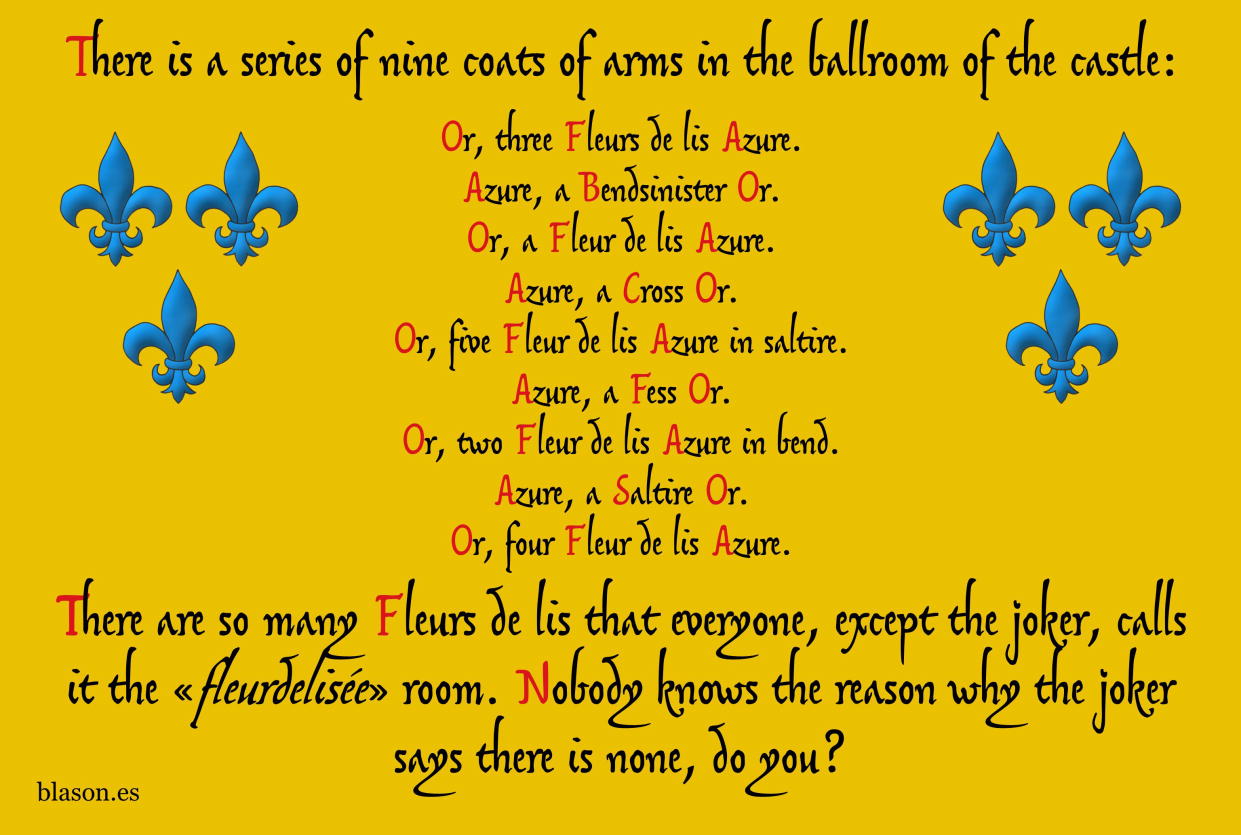
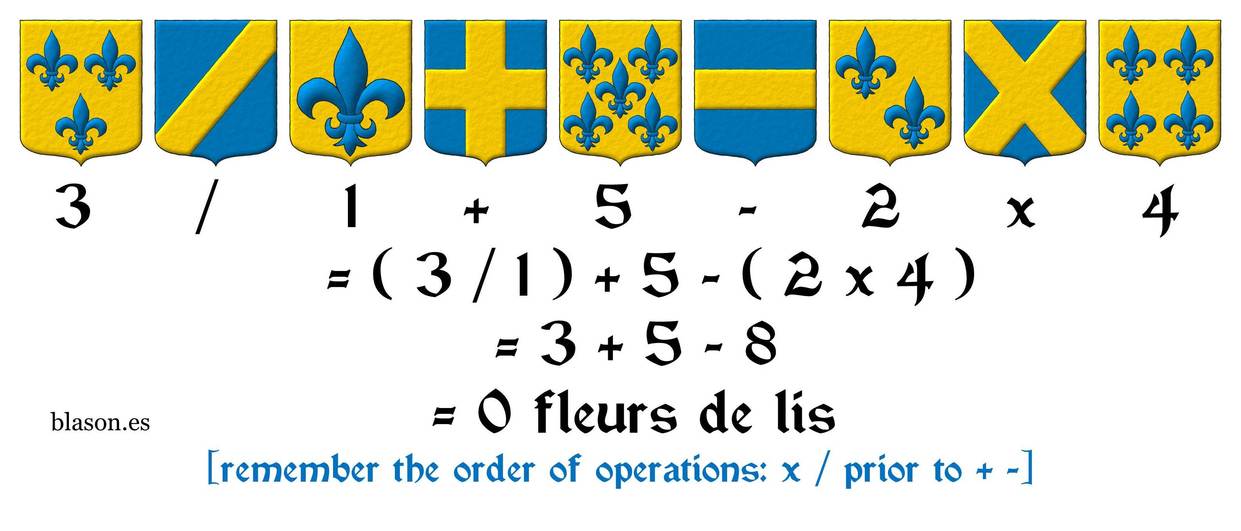


![City of Almeria, schema 4x3 Argent, a cross Gules [for Genoa]; a bordure compony of fifteen sections: 1, 6, and 11 Argent, a pomegranate seeded, slipped and leaved proper [for Granada]; 2, 7, and 12 Or, an eagle displayed Sable [for Navarre]; 3, 8, and 13 Gules, a castle triple-towered Or, port and windows Gules, masoned Sable [for Castile]; 4, 9, and 14 Argent, a lion rampant Purple, armed and langued Gules, crowned Or [for Leon]; 5, 10, and 15 Or, four pallets Gules [de Aragon].](../escudo_armas/AlmeriaM.40.Instagram.Esquema.4x3.Piel.jpg)
